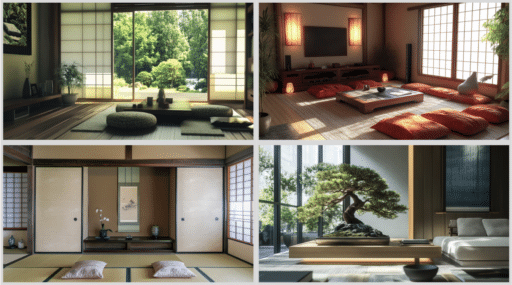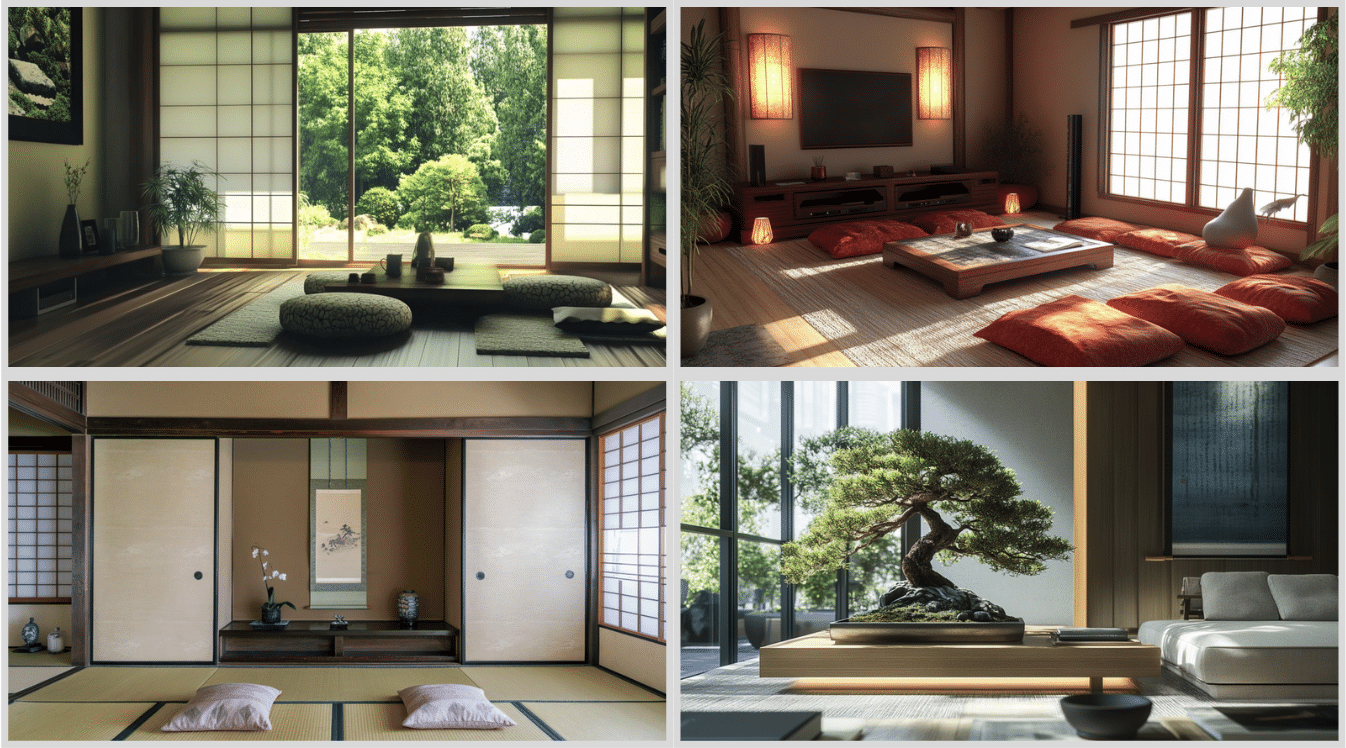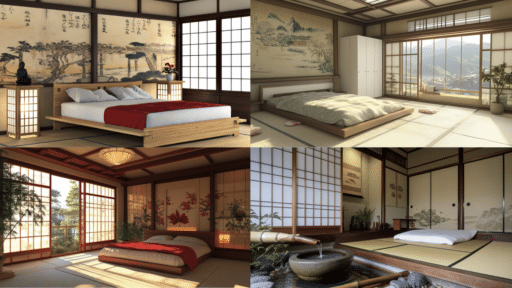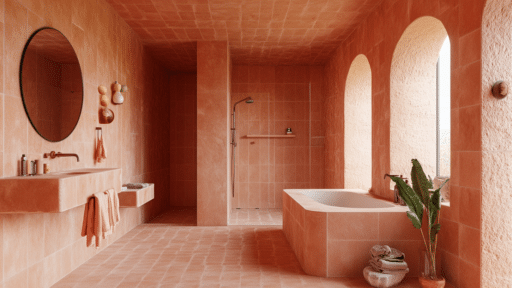Have you ever walked into a room and felt instantly calm? That’s the magic of Japanese living room design. It’s not just about looks – it’s a whole vibe.
Imagine a space where every item has a purpose, where simplicity meets comfort. Sounds nice, right? But here’s the thing: creating this look isn’t always easy.
You might wonder which items truly capture that Japanese feel. Don’t worry; we’ve got you covered. This guide will walk you through 35 must-have items for your Japanese living room.
From low tables to paper lanterns, we’ll show you how each piece adds to the overall charm. Ready to turn your living room into a zen retreat? Let’s jump in and realize how these items can transform your space.
35 Must-Have Items for Japanese Living Room Style
1. Tatami Mats
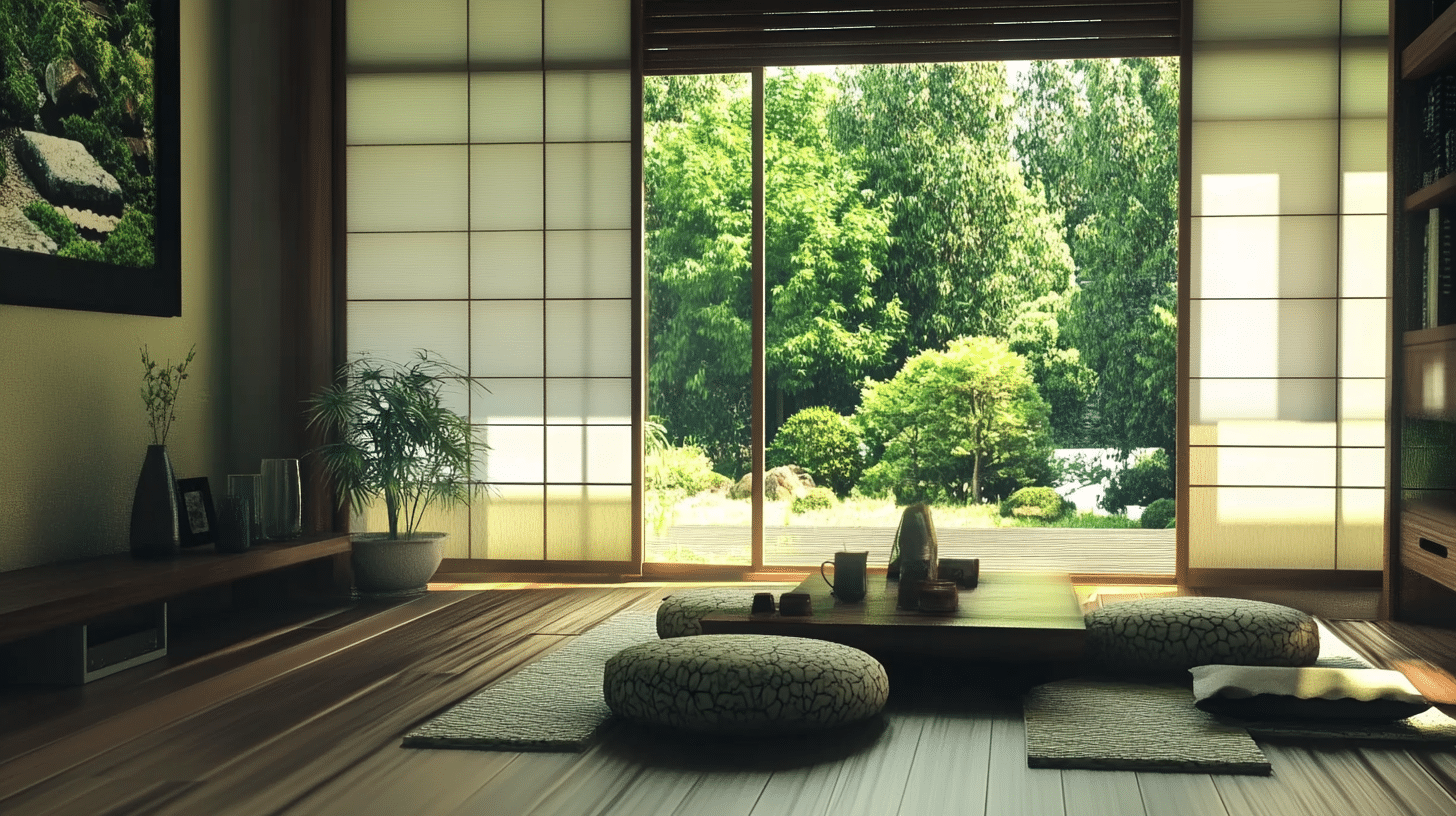
Tatami mats are traditional Japanese flooring made of rice straw and woven rush. Their distinct texture and scent contribute to a serene atmosphere.
Originating from the Heian Period, tatami mats were initially a luxury item for the nobility before becoming common in Japanese homes.
- Modern Usage: In modern homes, tatami areas are often used in living or sleeping areas, emphasizing minimalism and natural aesthetics.
- Styling Tips: To maintain a traditional Japanese look, complement tatami with low furniture, such as zabuton cushions or a kotatsu.
- Benefits and Challenges: Tatami are perfect for a natural look but require careful maintenance to avoid moisture and sunlight damage.
2. Shoji Screens
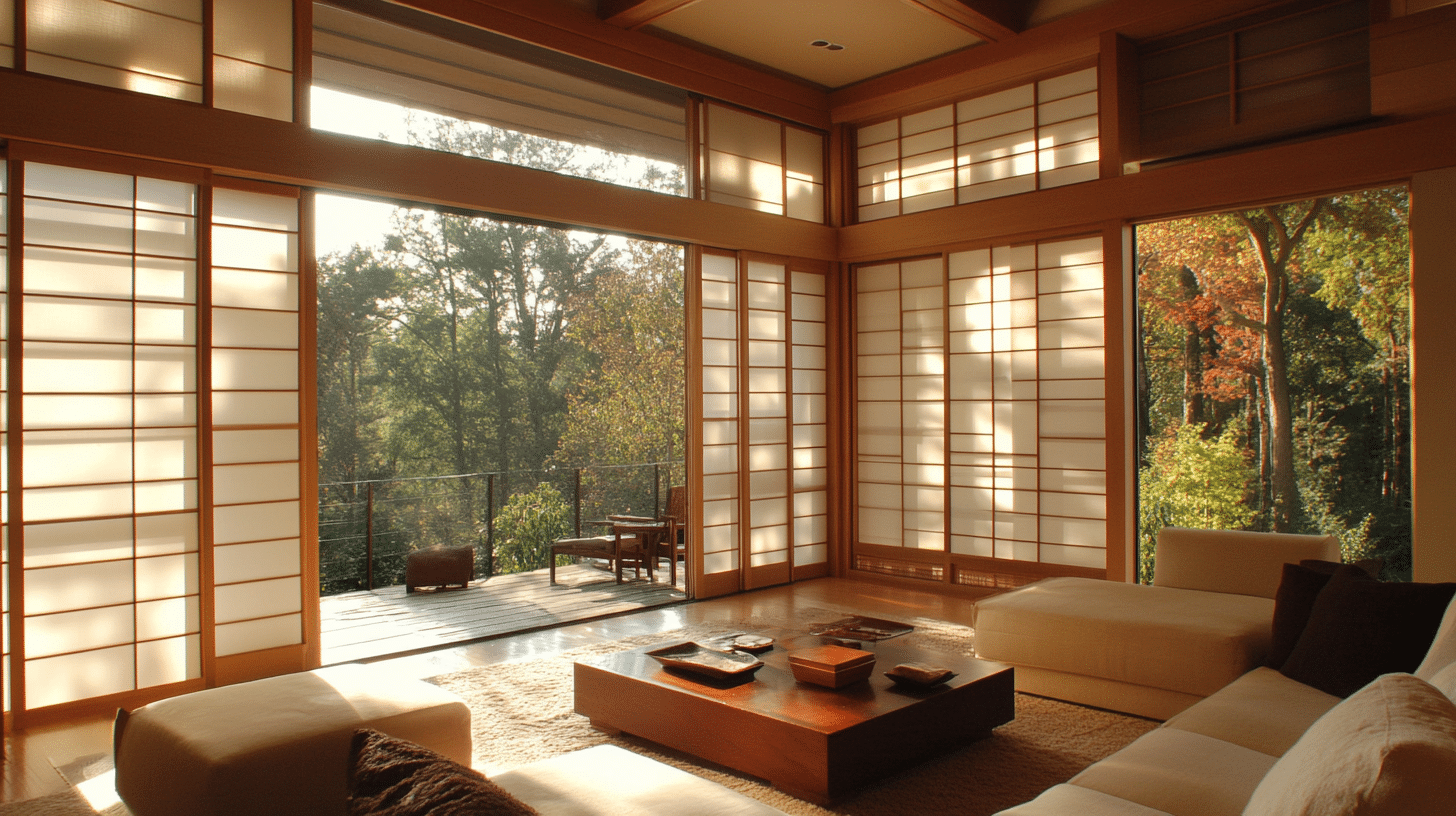
Shoji screens are sliding doors made from translucent paper and a wooden frame. They allow light to pass through while providing privacy.
Shoji screens have been used in Japanese architecture since the 8th century to separate spaces and diffuse light softly.
- Modern Usage: Today, shoji screens are used in homes worldwide to create versatile, light-filled spaces that maintain privacy.
- Styling Tips: Use shoji screens to subtly divide larger rooms or hide storage areas without sacrificing natural light.
- Benefits and Challenges: They allow for privacy while keeping rooms bright and airy, though they can be fragile and susceptible to tears.
3. Kotatsu
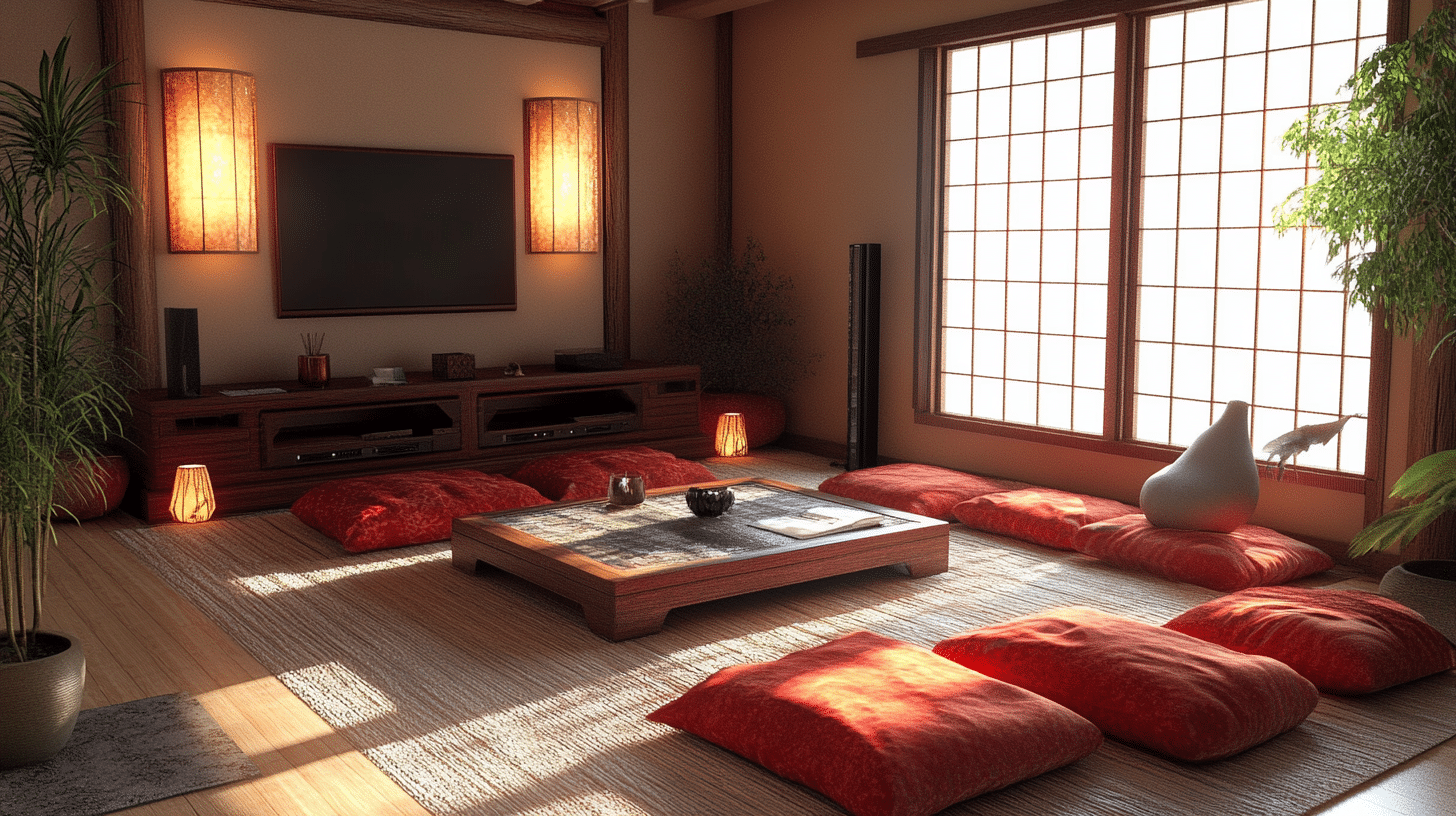
A kotatsu is a low wooden table frame covered by a futon or heavy blanket with a heat source underneath. It is used in many Japanese homes to stay warm.
Developed in the Muromachi period, the kotatsu was originally a cooking hearth before evolving into its current form.
- Modern Usage: Still popular in Japan, kotatsu is used for its warmth and as a place for family gatherings during colder months.
- Styling Tips: Pair a kotatsu with a sofa or floor cushions for a cozy living area that encourages family interaction.
- Benefits and Challenges: Kotatsus offer a unique heating option and a communal space, but they require careful handling to avoid burns or overheating.
4. Zabuton
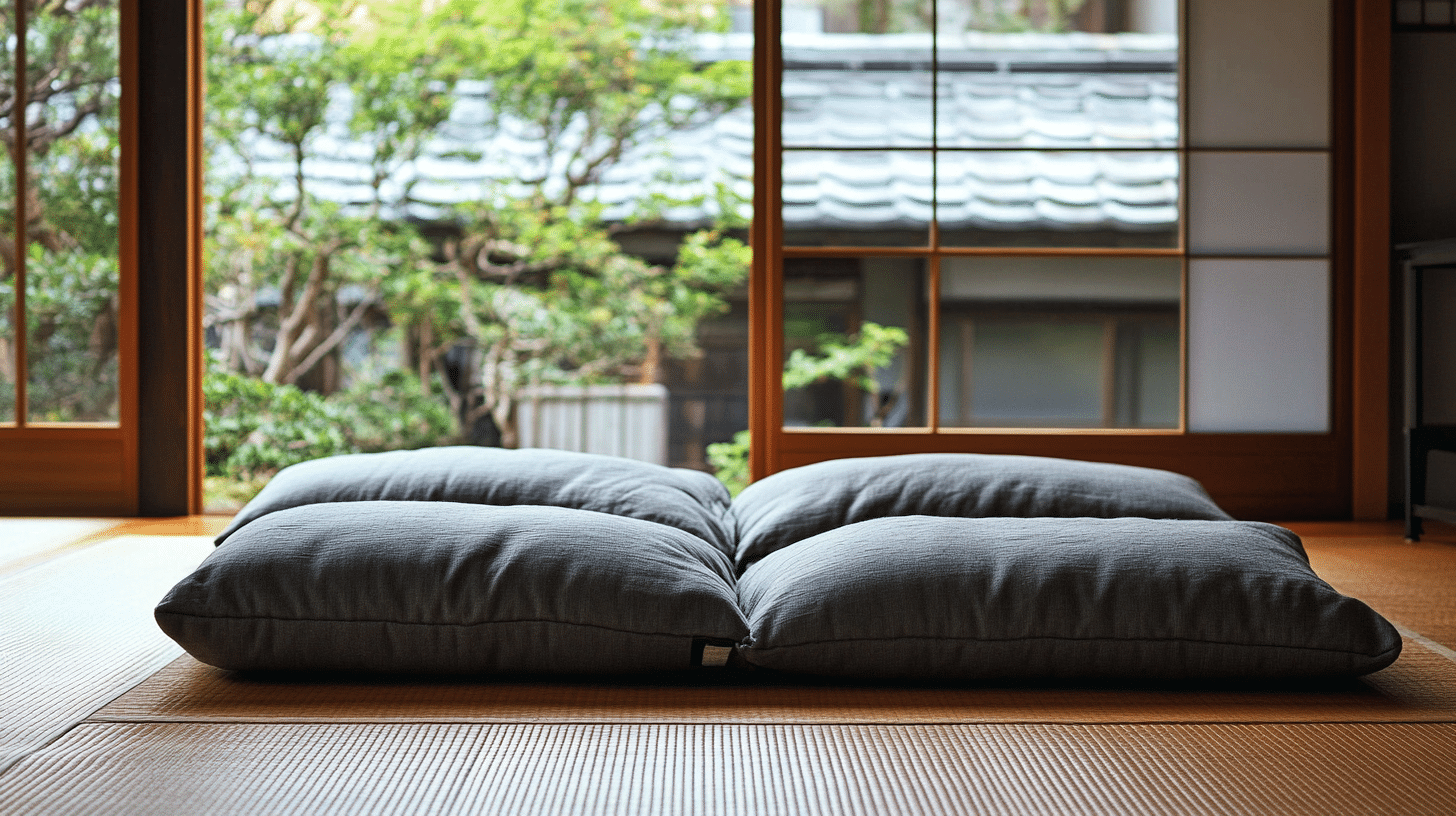
Zabuton are flat cushions used in traditional Japanese seating. They are typically made of cotton and placed on tatami floors for additional comfort.
Zabuton cushions have been part of Japanese life since the Kamakura period, often used in formal settings like tea ceremonies.
- Modern Usage: Beyond traditional settings, zabuton is common in casual home environments, offering flexible seating options.
- Styling Tips: Mix and match zabuton colors and patterns to add a vibrant touch to the minimalist decor of a Japanese-style room.
- Benefits and Challenges: Zabuton makes floor seating more comfortable and is easy to store, though it requires regular cleaning, especially in homes with pets or children.
5. Futon
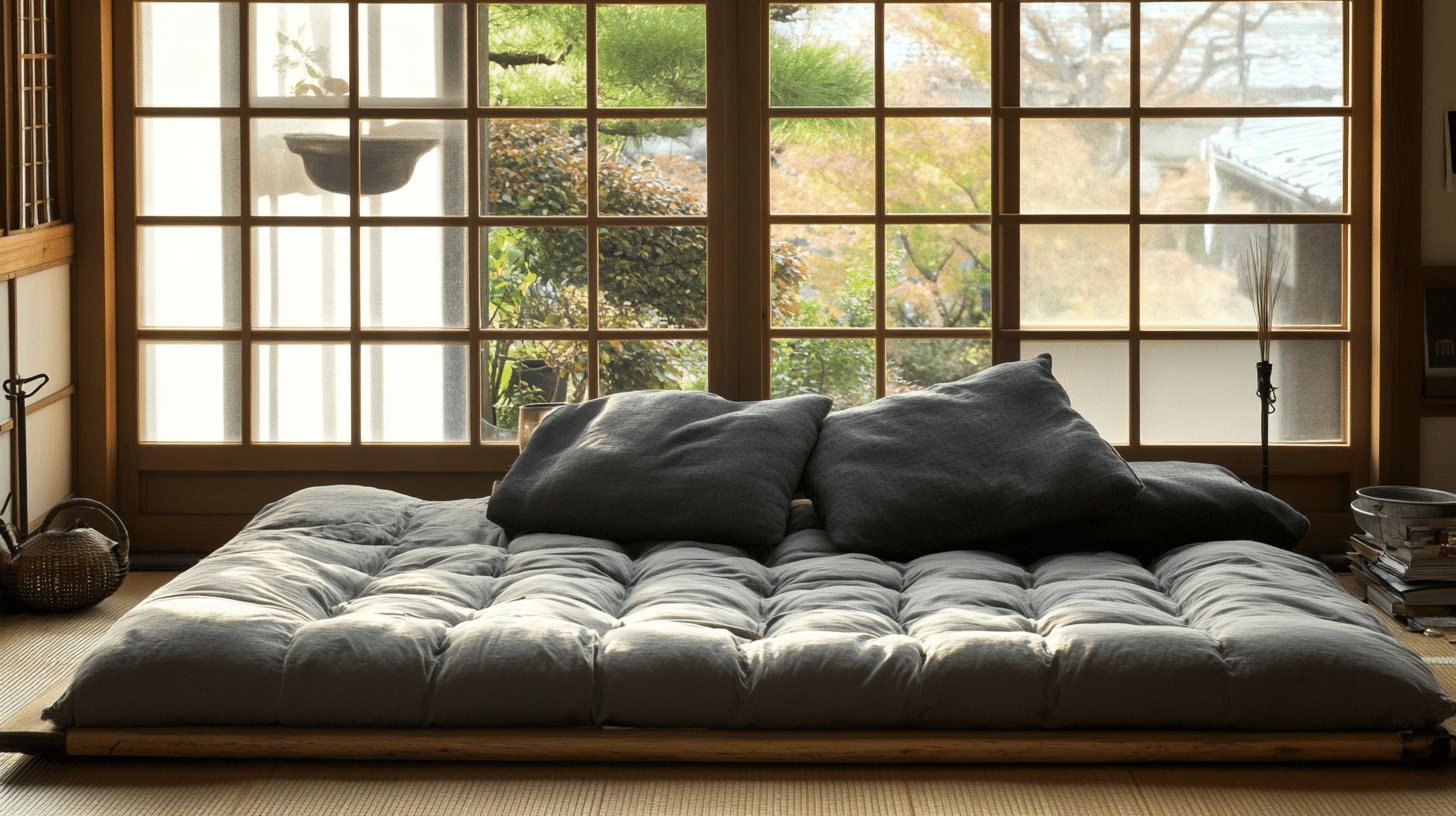
Futons are traditional Japanese-style bedding that can be easily folded and stored away, making them ideal for small living spaces.
Used in Japan for centuries, futons were designed to be stored during the day to free up space in multi-purpose rooms.
- Modern Usage: Futons are embraced globally, particularly in spaces that serve multiple purposes or have limited square footage.
- Styling Tips: Keep the futon’s color scheme neutral to match the calming, neutral palette typical of Japanese interiors.
- Benefits and Challenges: Futons are perfect for small spaces and easy to clean but require daily folding and lack the support of traditional mattresses.
6. Tokonoma
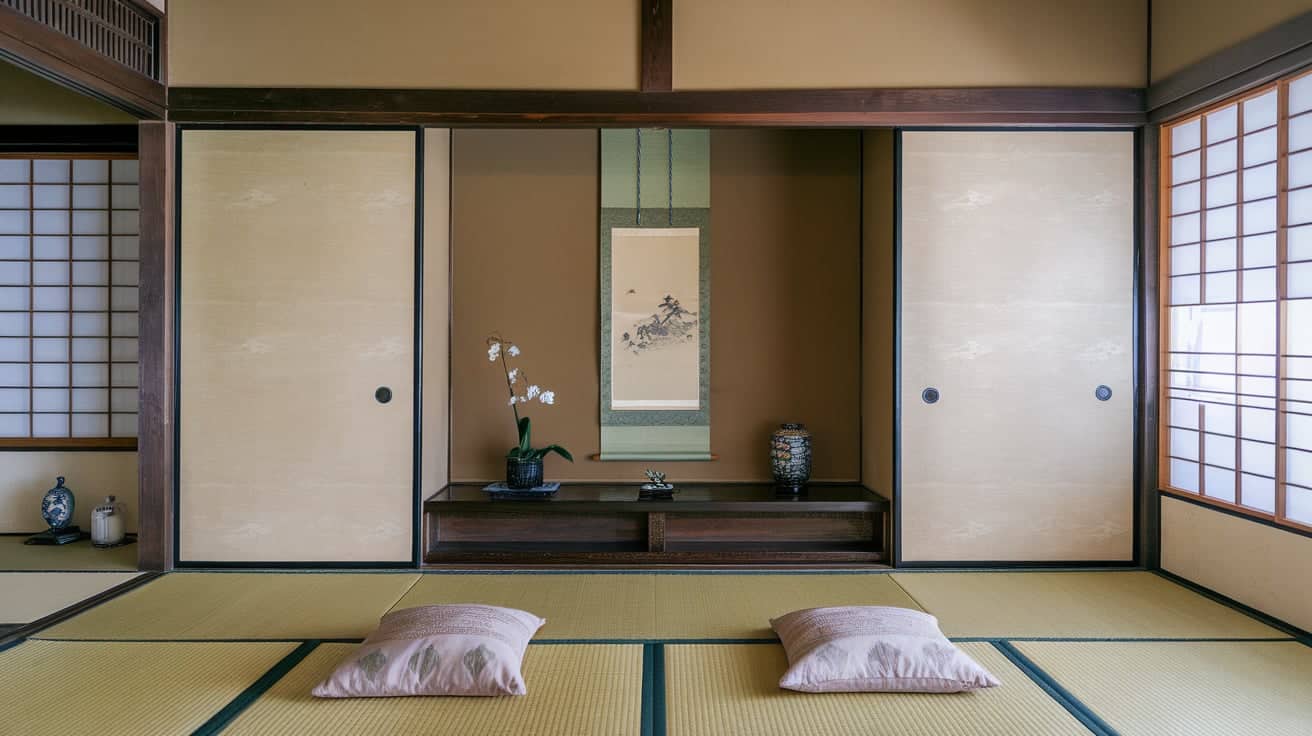
Tokonoma is a built-in recessed space in a Japanese living room. It displays art, bonsai, or ikebana, highlighting aesthetic appreciation and seasonal changes.
Tokonoma originated in the Muromachi period and has been a staple in traditional Japanese homes as a symbol of cultural refinement.
- Modern Usage: In contemporary homes, tokonoma spaces are often used as focal points for art display, blending tradition with modern decor.
- Styling Tips: Rotate displays in the tokonoma to reflect seasonal changes or special occasions, keeping the space dynamic and reflective of nature.
- Benefits and Challenges: Tokonoma enhances the living space’s beauty but requires thoughtful curation to avoid clutter and maintain simplicity and focus.
7. Chabudai
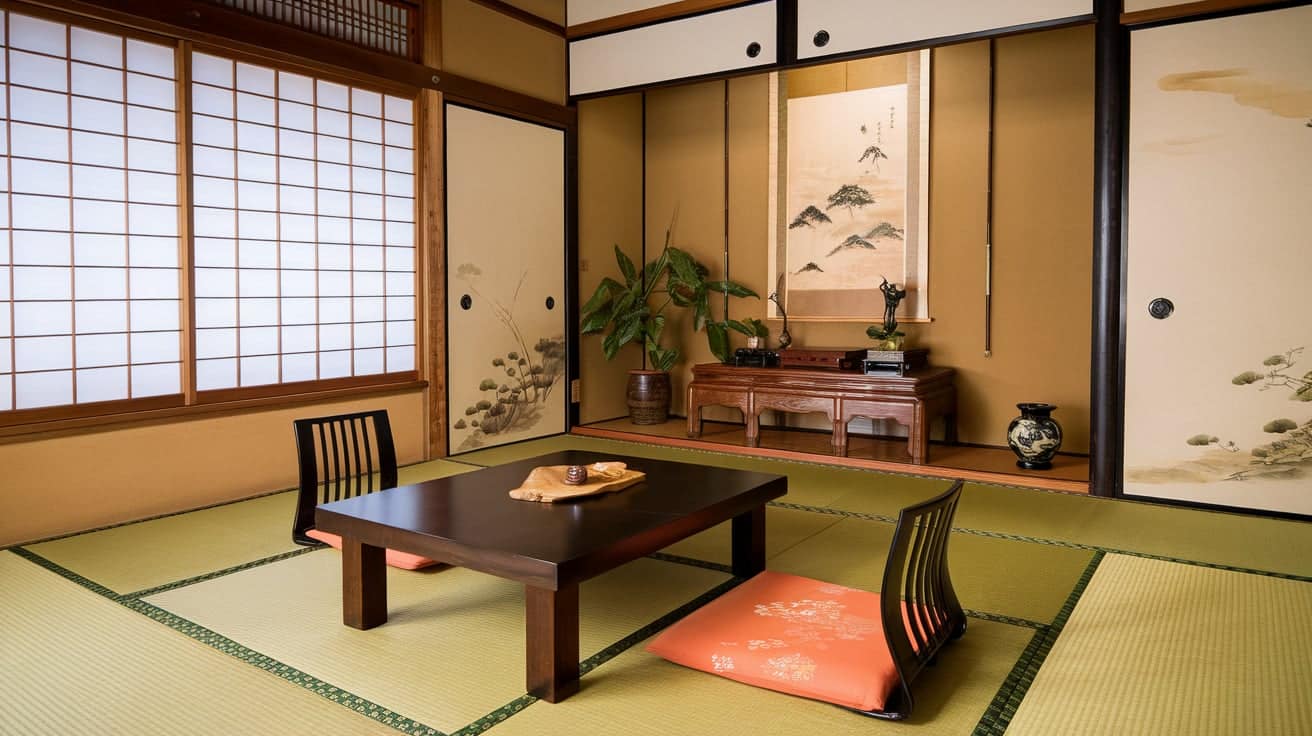
A chabudai is a low wooden table in traditional Japanese homes where family members gather for meals and tea.
Chabudai have been used since the Edo period as part of a lifestyle seated on the floor, promoting familial unity.
- Modern Usage: While less common in the latest homes, chabudai is appreciated for its minimalist and space-saving design in smaller apartments.
- Styling Tips: Accompany a chabudai with floor cushions in natural fabrics to maintain an earthy and cohesive look.
- Benefits and Challenges: Chabudai is ideal for low-seating arrangements and small spaces but may not be comfortable for everyone, especially those with mobility issues.
8. Noren
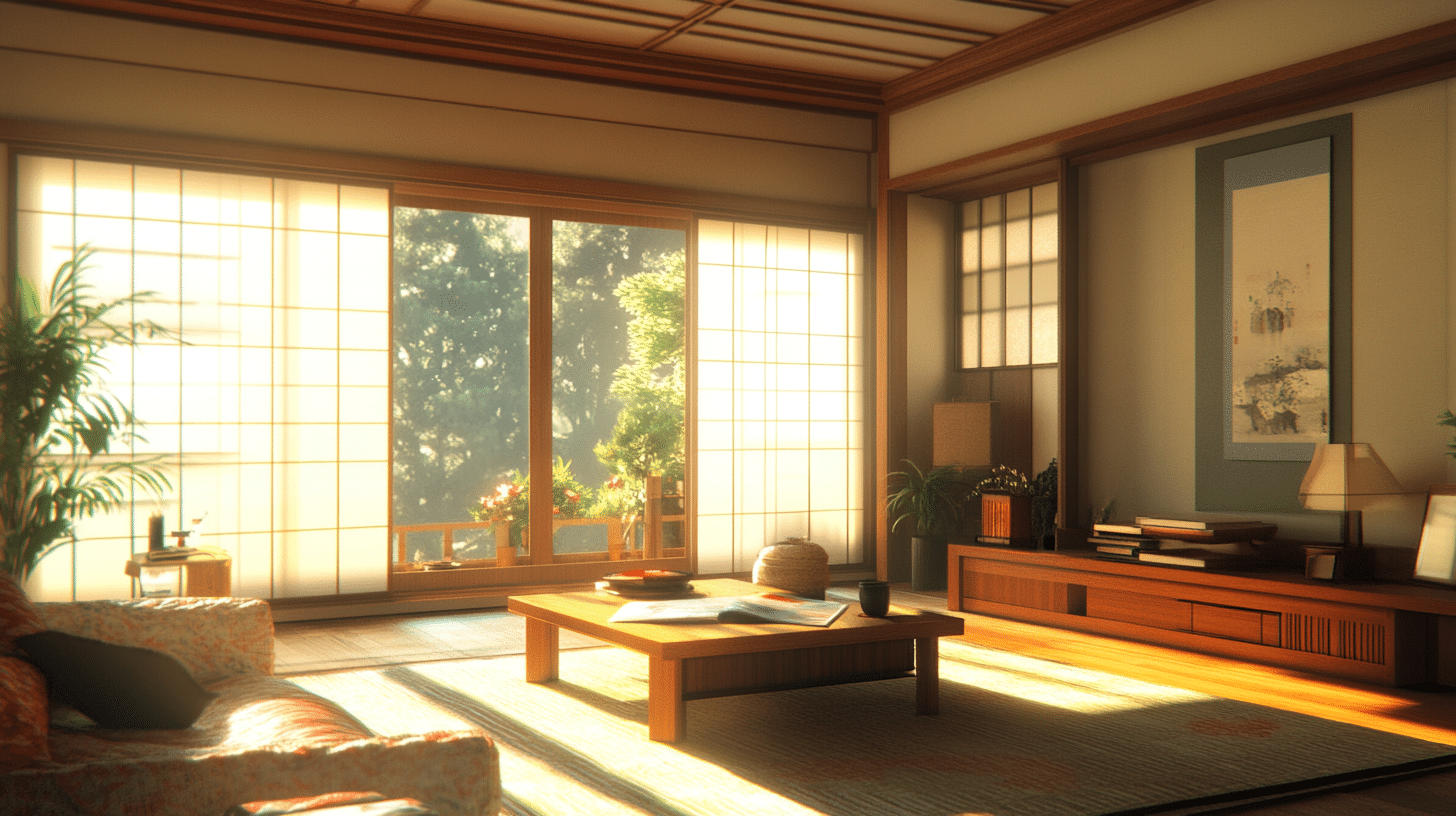
Noren are fabric dividers that hang in doorways or windows. They are traditionally used to protect a home from dust and wind and to signal the nature of a business.
Noren has been used in shops and onsens since ancient times to communicate messages about the type of establishment and indicate openness.
- Modern Usage: Noren is used in homes as decorative elements and privacy screens, adding color and interest to interiors.
- Styling Tips: Select noren with colors or patterns that complement other textiles in the room, such as curtains or cushions.
- Benefits and Challenges: Noren can transform a space aesthetically and functionally, but their placement near doorways may require frequent cleaning.
9. Washi Paper Lamps
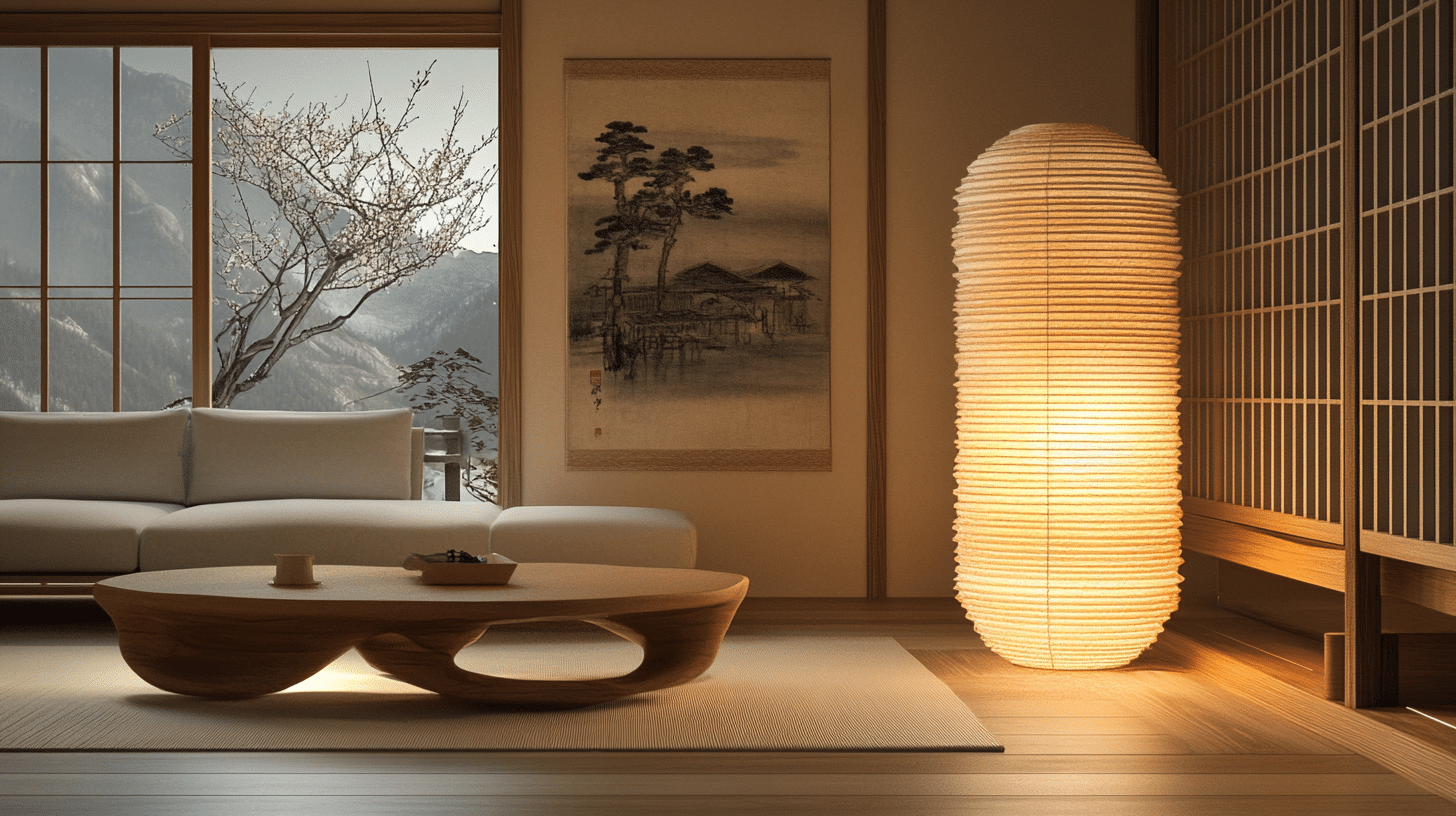
Washi paper lamps are made from traditional Japanese washi paper, which is known for its warm, diffuse lighting, which enhances any room’s ambiance.
Washi paper dates back to the Edo period. It was initially used for lanterns during festivals and has since become popular for home lighting.
- Modern Usage: These lamps are favored for their soft, ambient light in modern decor, which is suitable for creating a relaxing atmosphere.
- Styling Tips: Use washi paper lamps as accent lighting in corners or over dining areas to provide gentle, non-intrusive light.
- Benefits and Challenges: It provides beautifully diffused light that is easy on the eyes, but the paper can be fragile and susceptible to tears or water damage.
10. Bonsai Trees
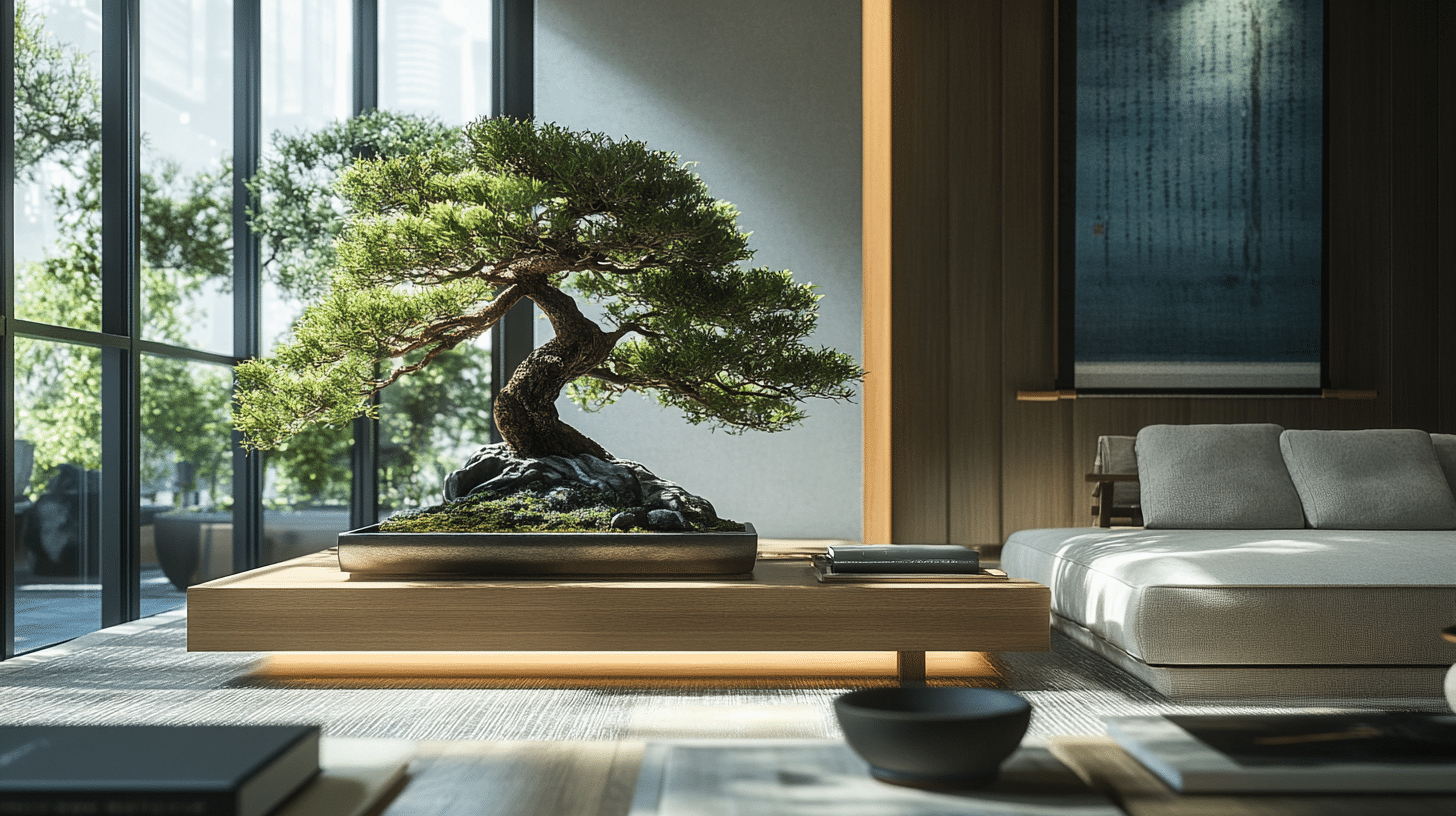
Bonsai trees are miniature trees kept in small pots, shaped over years to create a balanced, aesthetically pleasing form that epitomizes the Japanese art of miniaturization.
Bonsai art has been practiced in Japan for over a thousand years, influenced by earlier Chinese practices of penjing.
- Modern Usage: Bonsai are popular in homes worldwide as a symbol of harmony, patience, and diligence. They add greenery and artistry to any room.
- Styling Tips: To maintain their health and visual appeal, bonsai should be placed in areas with natural light and away from direct heat sources.
- Benefits and Challenges: Bonsai trees can dramatically enhance a space’s visual appeal. However, they require precise care and maintenance, which can be daunting for beginners.
11. Hanging Scrolls
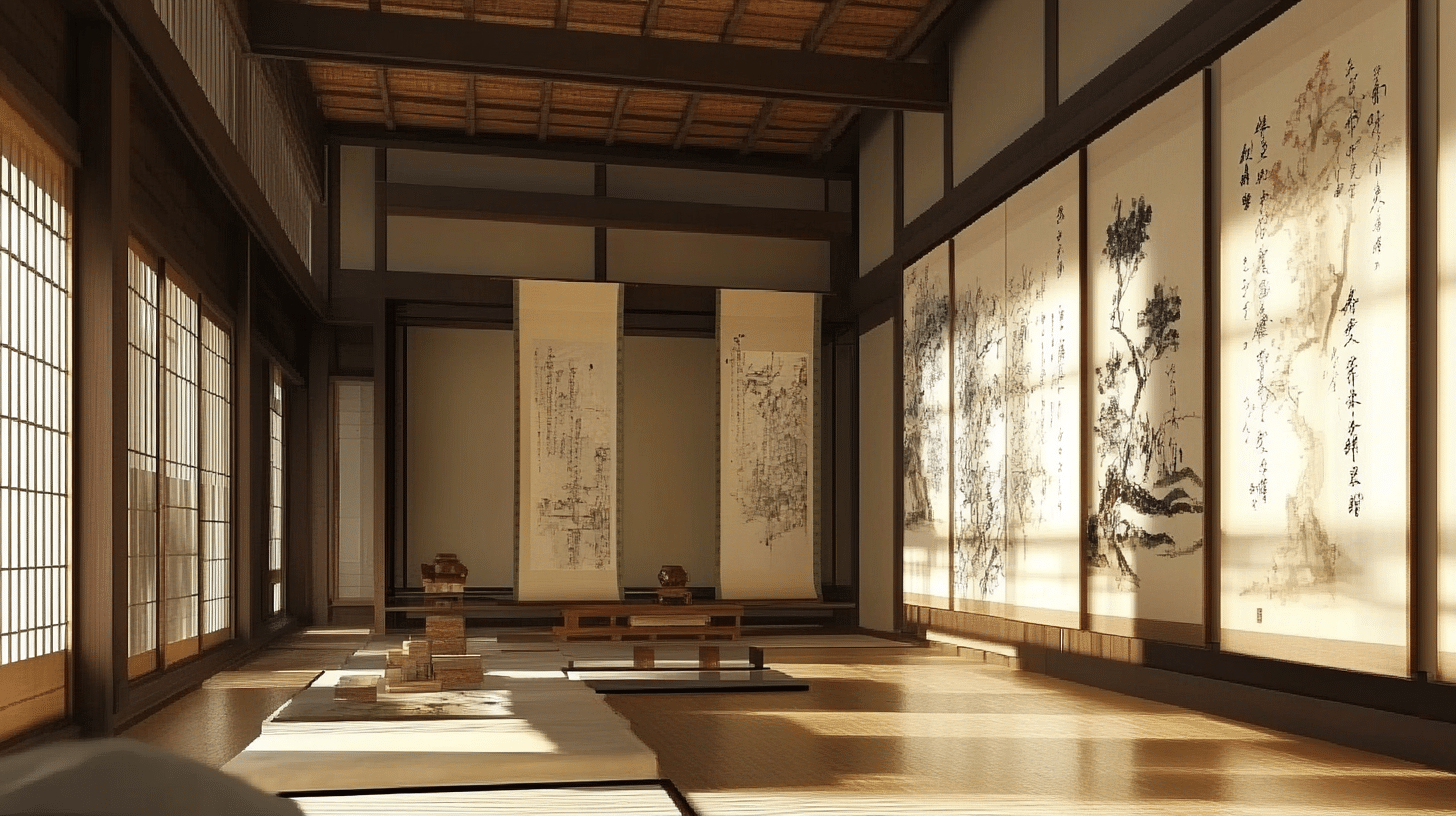
Hanging scrolls, known as Kakejiku, are integral to traditional Japanese decor. They display calligraphy or paintings that are often seasonal or inspirational.
Kakejiku have been used in tea ceremonies and religious settings since the Heian period, serving as a focal point for contemplation and aesthetics.
- Modern Usage: Modern homes incorporate hanging scrolls as versatile art pieces that can be changed to match the season or mood.
- Styling Tips: Hang scrolls at eye level in quiet spaces of the home where they can be appreciated, like the tokonoma or near a study area.
- Benefits and Challenges: Scrolls add a dynamic cultural element that can be periodically updated. However, they require careful handling to avoid damage.
12. Tansu
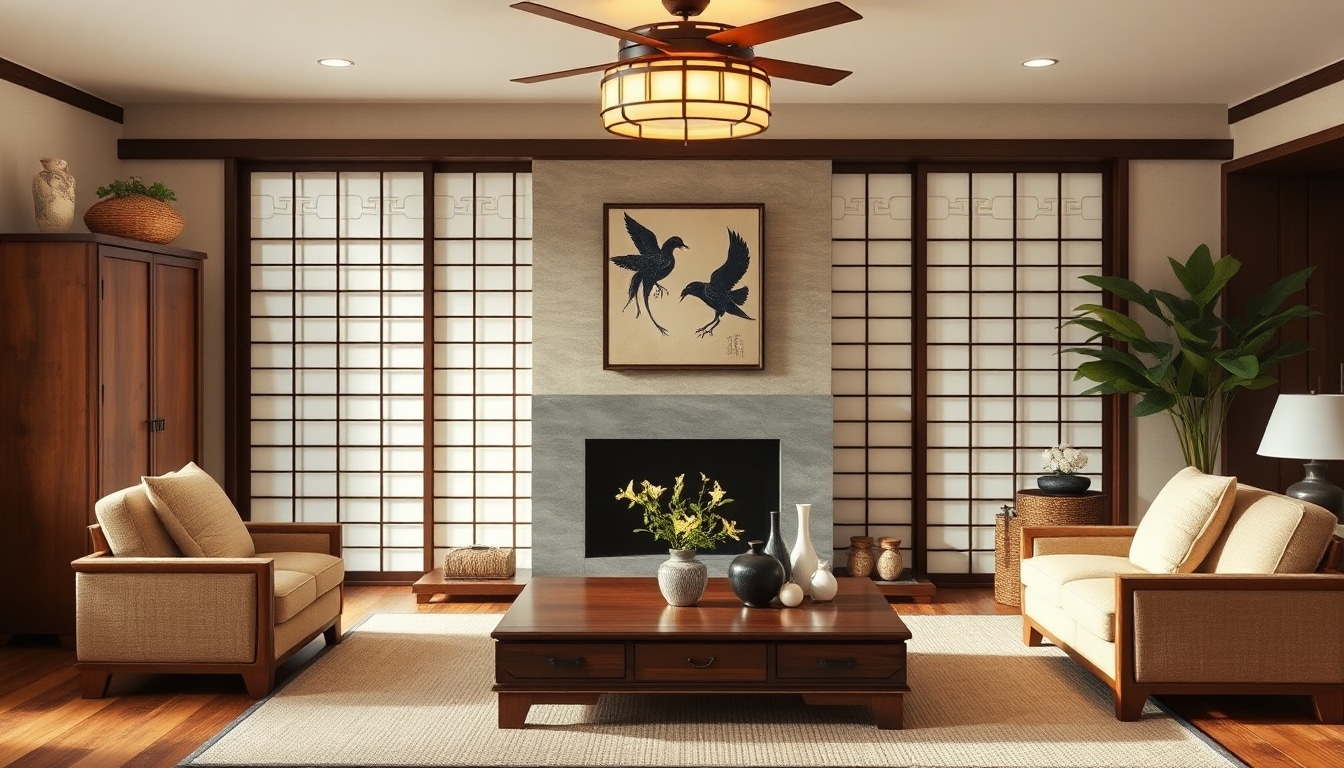
Tansu refers to traditional Japanese cabinets or chests known for their practical storage and rustic aesthetic.
Originating in the Edo period, tansu were used for various purposes, including clothing storage and kitchen needs, reflecting Japan’s minimalist and efficient design ethos.
- Modern Usage: Today, tansu can be used in any room of the home, admired for their craftsmanship and versatility.
- Styling Tips: Use smaller tansu in living areas to store items discreetly or as a stand for displaying other decorative items.
- Benefits and Challenges: Tansu provides ample storage and a touch of historical decor but can be bulky and need adequate space to be showcased properly.
13. Japanese Tea Set
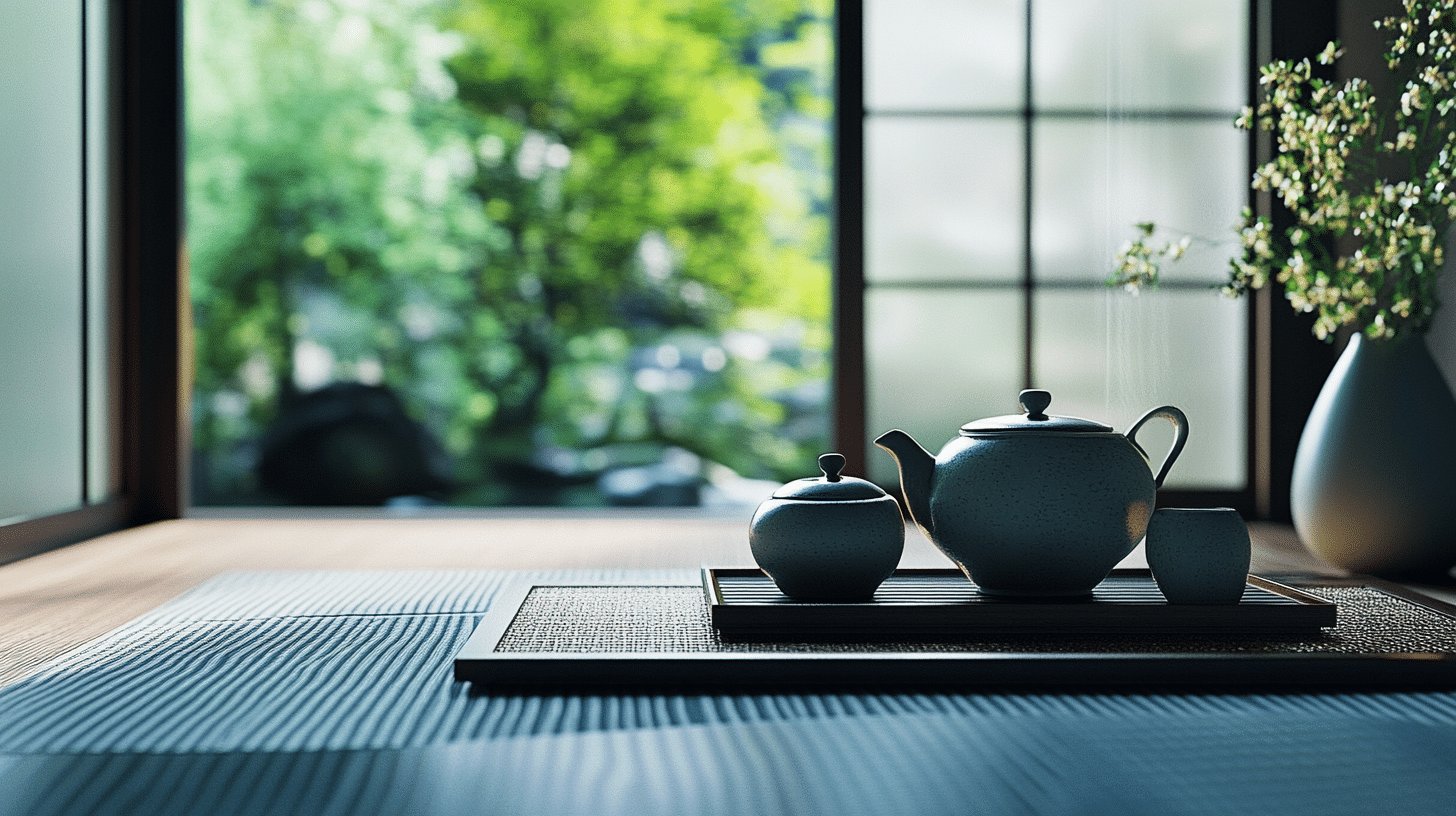
A Japanese tea set typically includes a teapot and matching cups, often made from ceramics, used for serving green tea and performing tea ceremonies.
Tea sets became integral to the Japanese tea ceremony, or Chanoyu, which evolved under Zen influences to foster harmony and respect.
- Modern Usage: These tea sets can also be used for ceremonial purposes and as a daily enjoyment tool, offering a tranquil break in modern homes.
- Styling Tips: When not in use, display the tea set on a chabudai or a dedicated tea cabinet, enhancing the room’s decor.
- Benefits and Challenges: Tea sets are functional and decorative but require careful handling and maintenance to preserve craftsmanship.
14. Sake Set
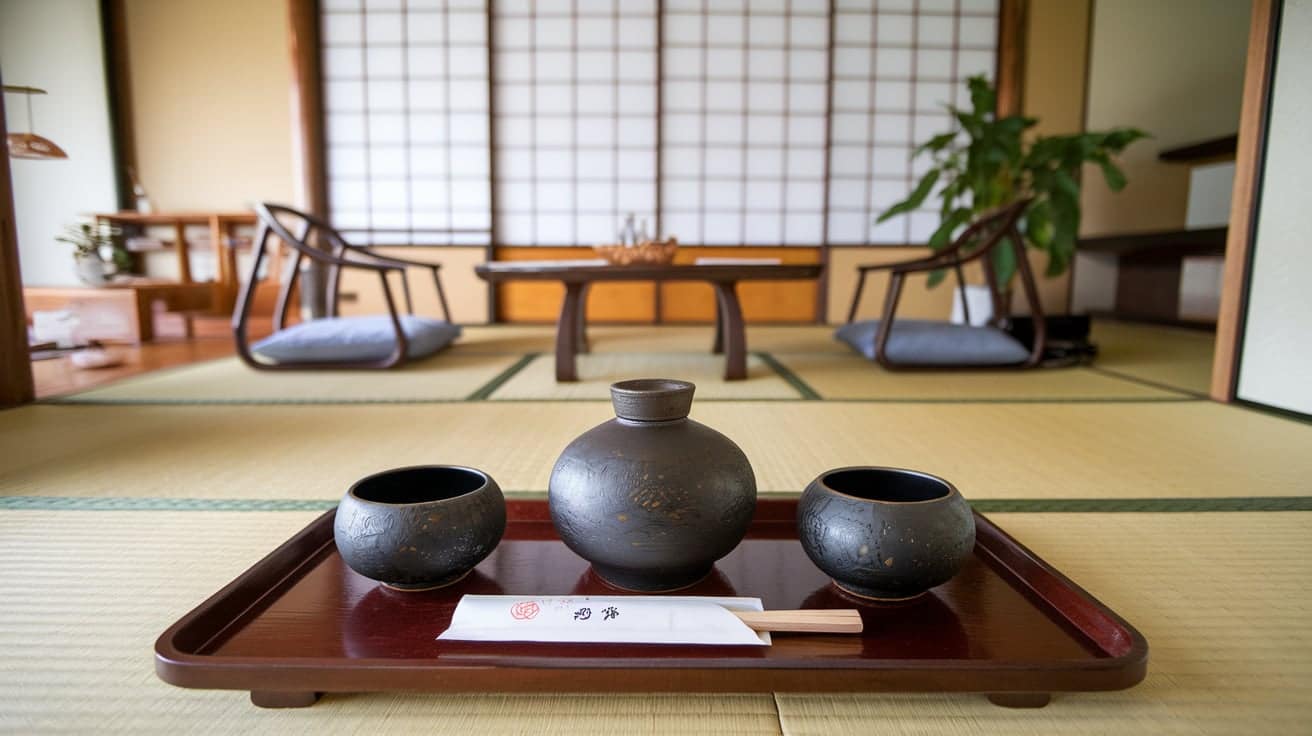
Sake sets, consisting of a tokkuri (sake bottle) and ochoko (sake cups), are used for serving sake, an integral part of Japanese dining culture.
Sake has been consumed in Japan for centuries, and the sake set is designed to enhance the experience, focusing on the taste and temperature of the drink.
- Modern Usage: Sake sets are used in homes to entertain guests or prepare special meals, contributing to an authentic Japanese dining experience.
- Styling Tips: Display the sake set in a visible dining room area or on a sideboard as a decorative reminder of Japanese hospitality.
- Benefits and Challenges: Sake sets can add a cultural flair to dining and are generally small and easy to store, though they are fragile and need careful handling.
15. Displayed Kimonos
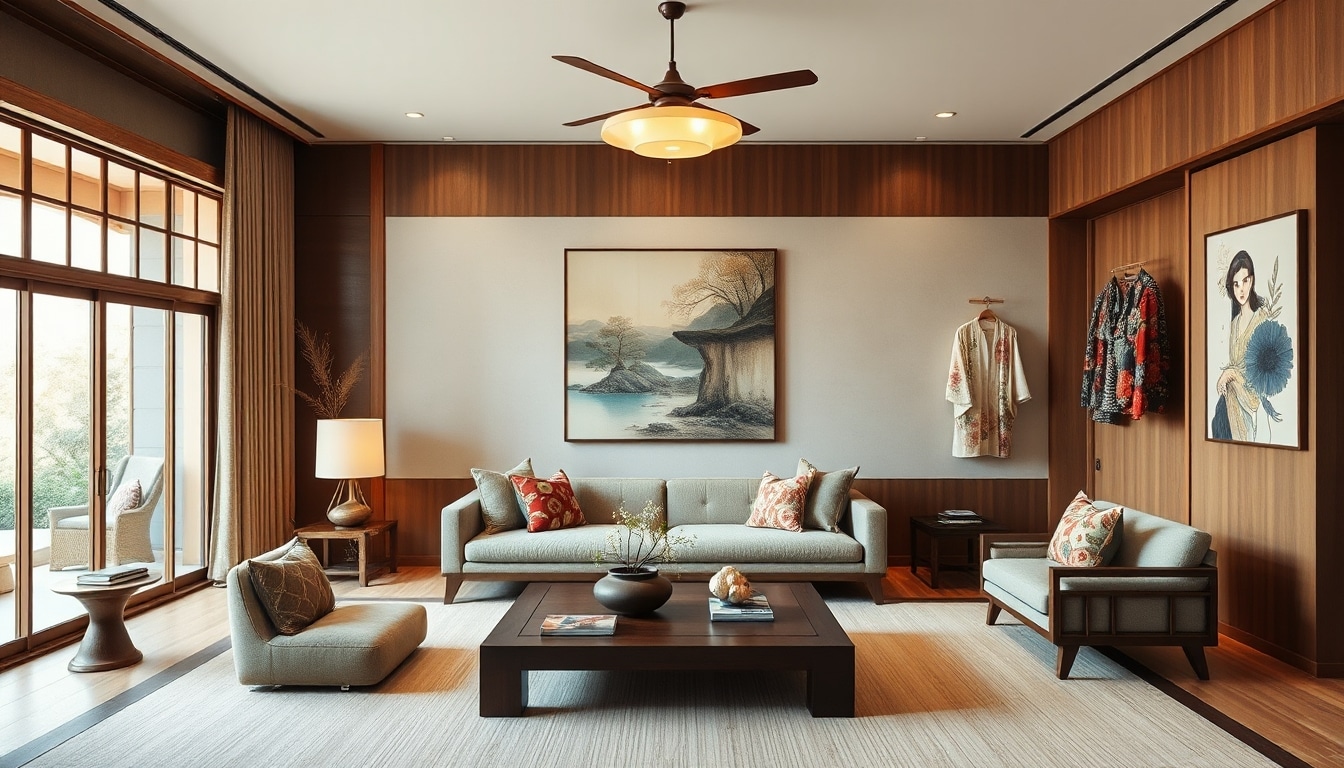
Displayed kimonos are traditional Japanese garments often used as wall decorations due to their beautiful fabrics and designs.
Kimonos were everyday attire in Japan until Western clothing became common; now, they are often worn on special occasions and appreciated as art.
- Modern Usage: Kimonos are displayed as part of home decor and bring color, texture, and cultural history into modern interiors.
- Styling Tips: Mount a kimono on a neutral wall or use a display frame to highlight its design and craftsmanship without overwhelming the space.
- Benefits and Challenges: Kimonos serve as stunning decor elements but must be preserved carefully to prevent fading and damage from exposure.
16. Bamboo Accents
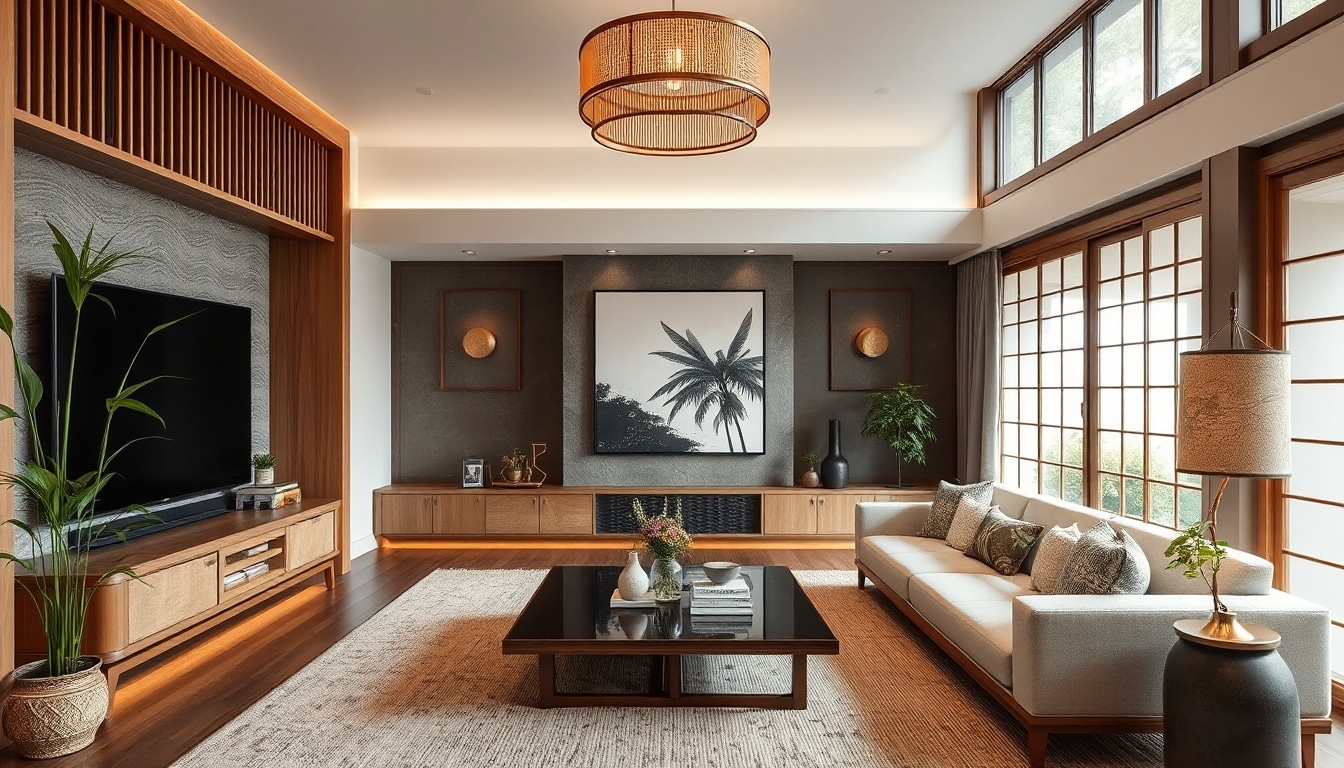
Bamboo is a versatile material used in various forms, such as furniture, mats, and decorative pieces, bringing a touch of nature and sustainability into the home.
Bamboo has been used in Japanese construction and crafts for centuries due to its strength and availability.
- Modern Usage: Bamboo accents are popular in eco-friendly and minimalist designs, offering durability and a clean aesthetic.
- Styling Tips: To maintain a cohesive natural theme, incorporate bamboo into functional items like frames, mats, or blinds or use it in decorative objects.
- Benefits and Challenges: Bamboo is sustainable and robust, making it ideal for everyday use, though it requires maintenance to prevent splitting and discoloration.
17. Zen Garden Elements
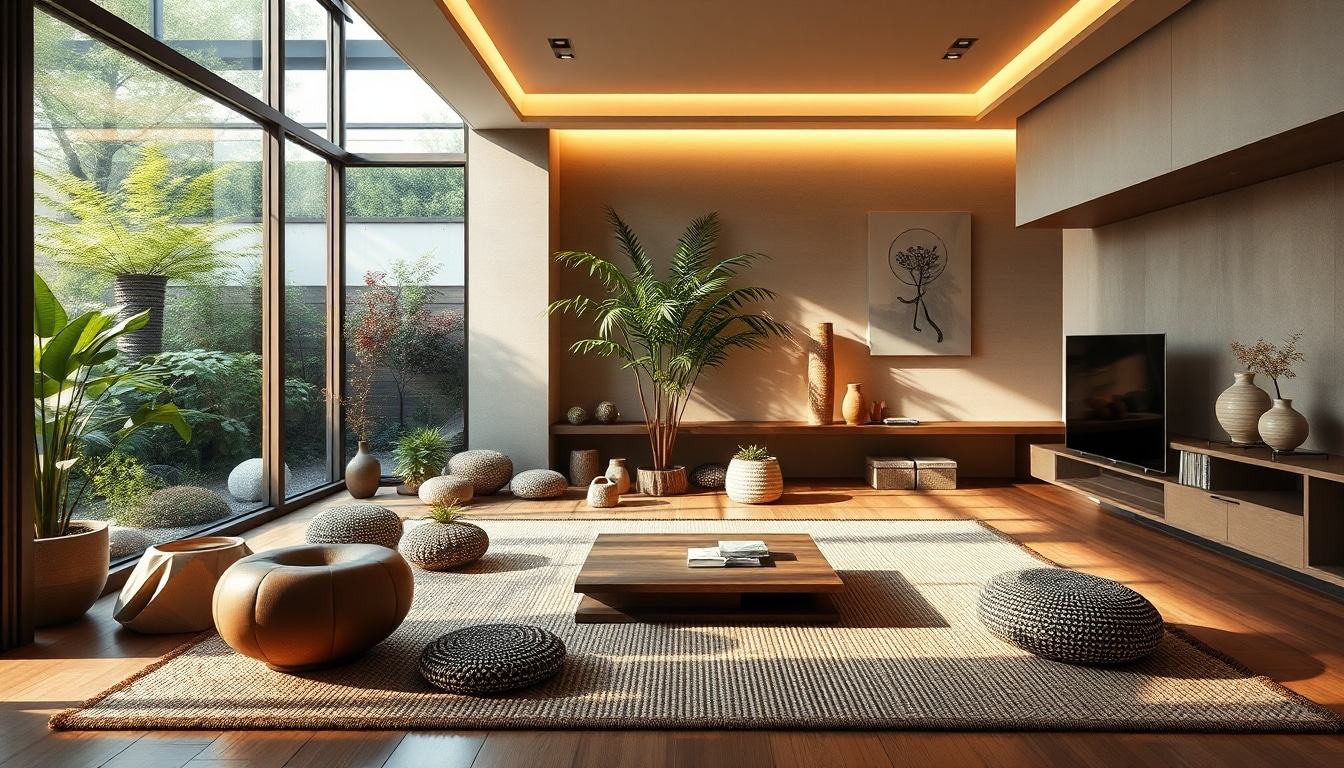
Zen garden elements like rocks, sand, and miniature shrubs can be incorporated indoors in small containers to bring tranquility and focus to a space.
Zen gardens are critical to Japanese monastery landscapes, designed for meditation and reflection.
- Modern Usage: Small indoor Zen gardens are used in living spaces to reduce stress and add a peaceful natural element.
- Styling Tips: Place a miniature Zen garden on a low table or shelf where it can be easily seen and interacted with, using fine sand and stones for simplicity and serenity.
- Benefits and Challenges: They offer a meditative quality to interiors but require regular raking and maintenance to preserve their designed patterns.
18. Ikebana Vases
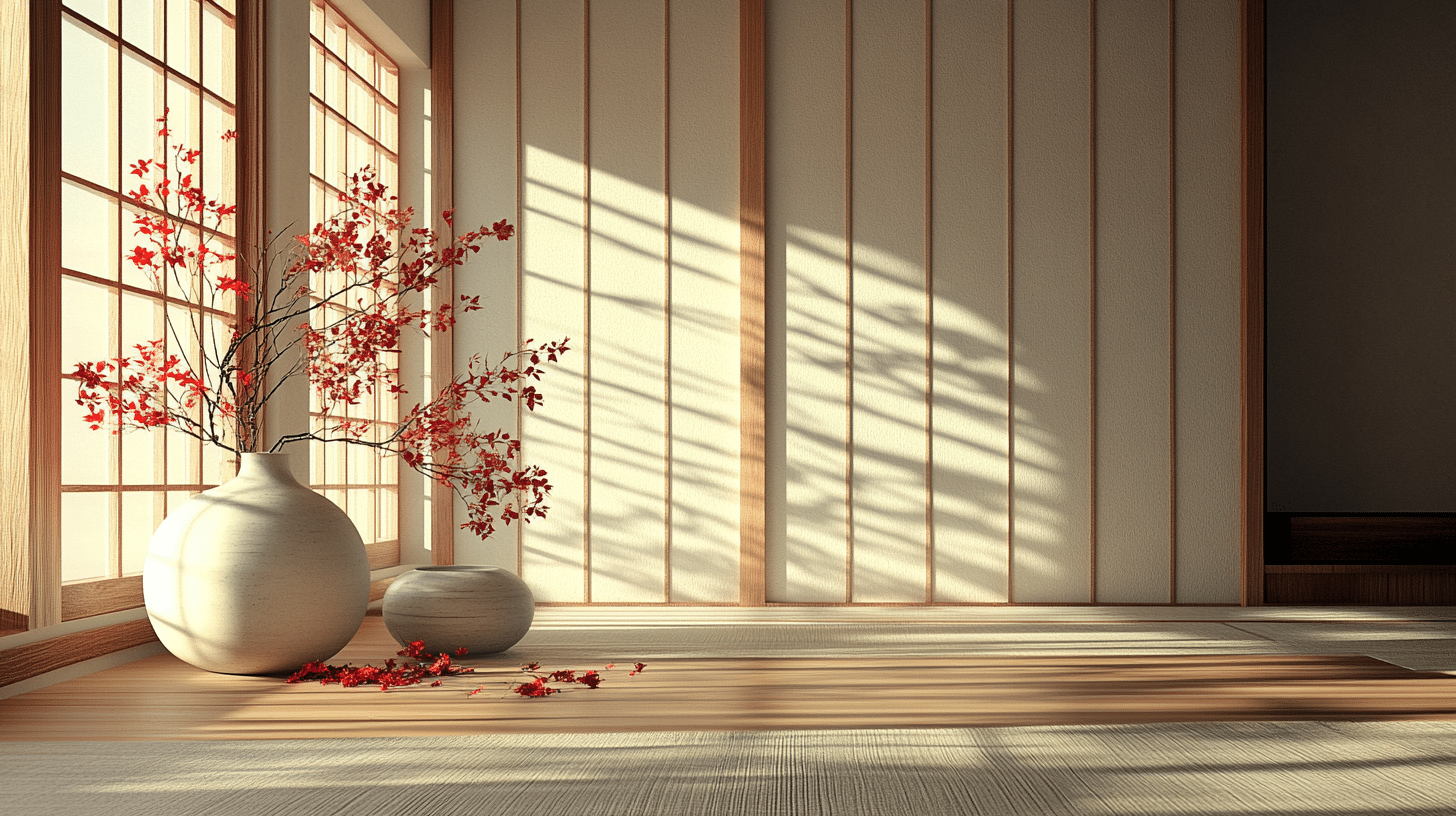
Ikebana vases are specially designed for the Japanese art of flower arranging. They are known for their minimalistic yet bold aesthetic, which enhances the natural beauty of the arrangement.
Ikebana is a disciplined art form with roots in the 7th century. It emphasizes form and balance in floral design.
- Modern Usage: Ikebana vases are used for traditional flower arranging and as standalone decorative pieces in modern homes.
- Styling Tips: Choose a vase that complements the color and structure of the flowers used; simple, bold colors in vases help highlight the flowers’ delicate details.
- Benefits and Challenges: Ikebana vases encourage creativity in floral arrangements but require some knowledge of ikebana principles to be used effectively.
19. Wooden Platforms
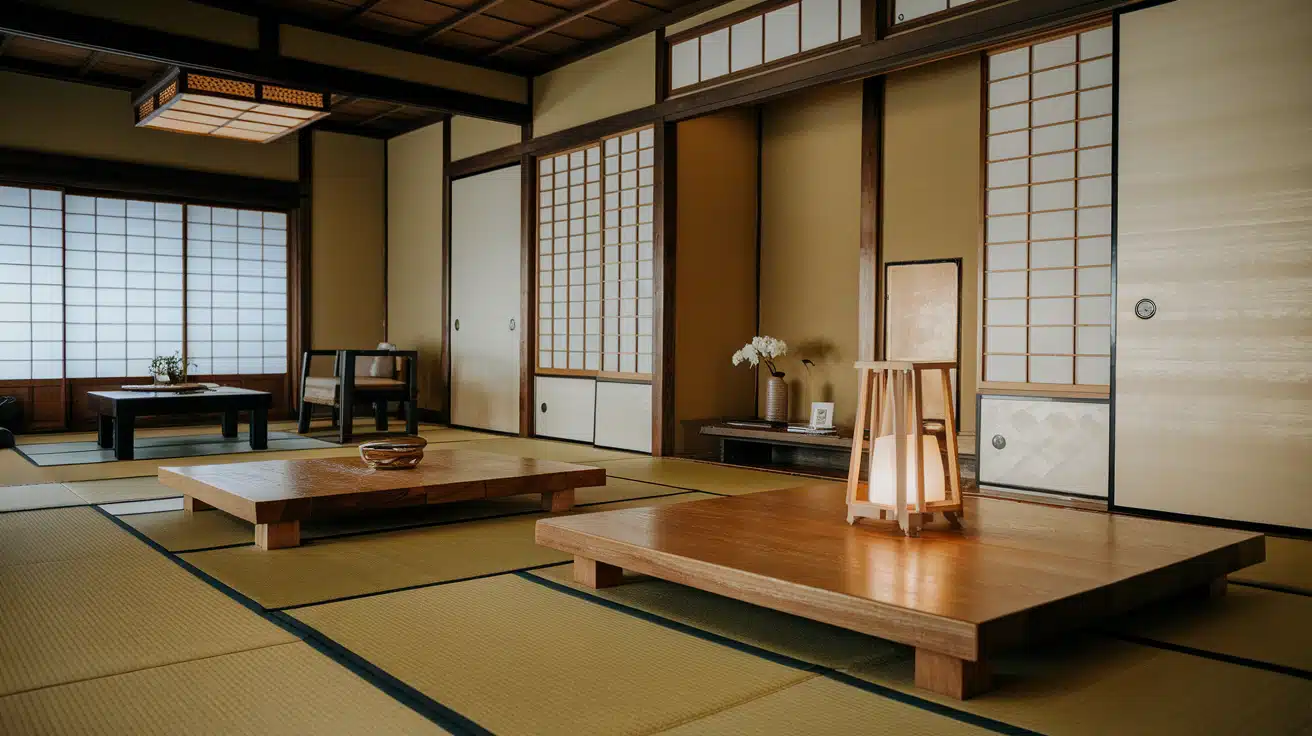
Wooden platforms are often used in traditional Japanese homes for defining a sleeping or sitting area, which elevates the designated space slightly above the floor level.
They are traditionally used in Japanese architecture to delineate important spaces within a room, like the tokonoma.
- Modern Usage: In contemporary homes, wooden platforms can separate living areas or serve as a base for beds and seating.
- Styling Tips: Utilize platforms under mattresses or seating groups to define spaces and add warmth and structure to the room.
- Benefits and Challenges: Platforms provide clear visual separation in open-plan spaces but require careful planning to integrate smoothly into existing designs.
20. Origami Decorations
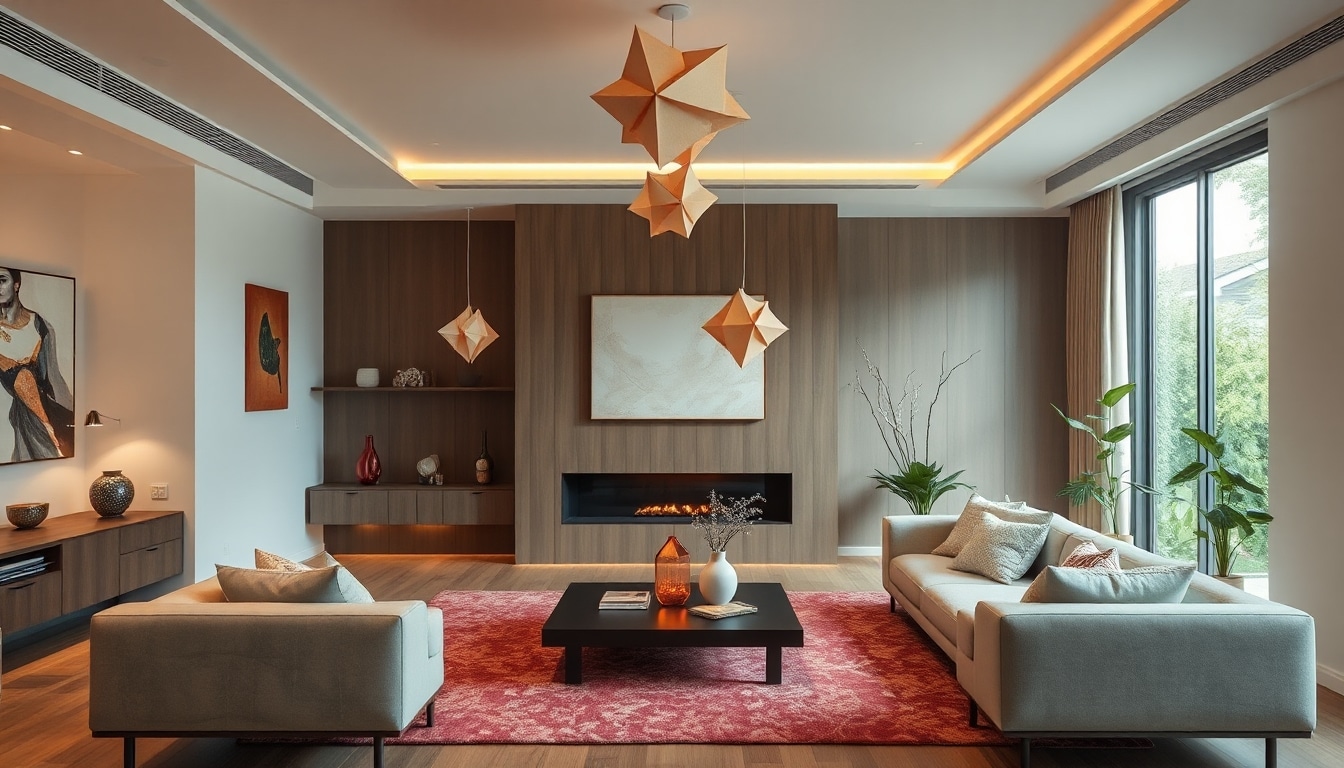
Origami, the art of paper folding, creates intricate decorative items that can add whimsy and color to any room.
Origami started in the 17th century but became popular in the Edo period as paper became more widely available.
- Modern Usage: Origami decorations can range from simple models to complex structures used in mobiles, wall art, or tabletop displays.
- Styling Tips: Hang origami figures in windows or arrange them on surfaces that can catch light and cast interesting shadows.
- Benefits and Challenges: Origami is a budget-friendly decoration that fosters creativity; however, paper decorations are fragile and may be temporary.
21. Ceramic Statues
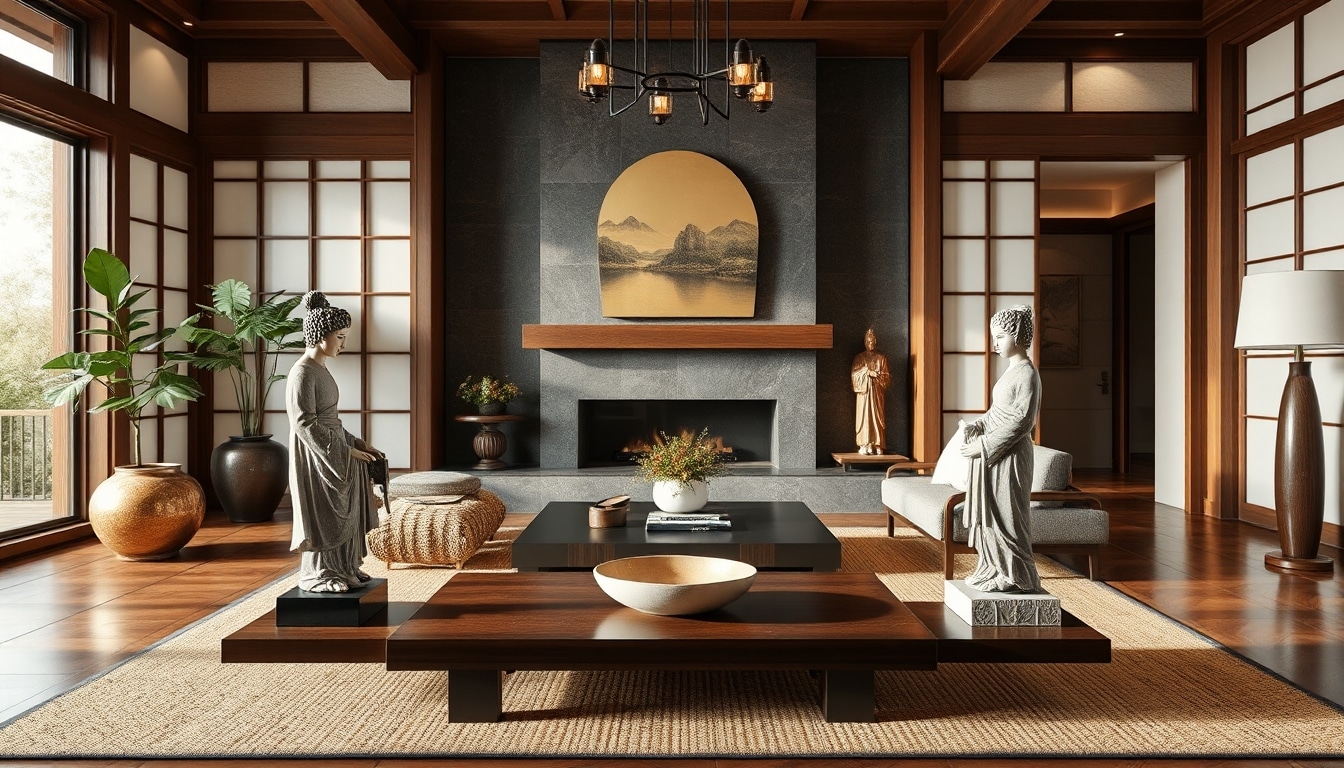
Ceramic statues, such as Maneki-neko (the beckoning cat) or Jizo statues, are traditional ornaments that add cultural depth and charm to any setting.
Ceramics have been part of Japanese art for centuries, with specific figures like Maneki-neko believed to bring good luck.
- Modern Usage: These statues are often used as decorative elements in homes and businesses, appreciated for their aesthetic and symbolic values.
- Styling Tips: Place ceramic statues in entryways or shelves where they can be viewed easily and contribute to the room’s ambiance.
- Benefits and Challenges: Ceramic statues are durable and imbue spaces with a touch of Japanese tradition, though they are fragile and require careful placement to avoid breakage.
22. Calligraphy Sets
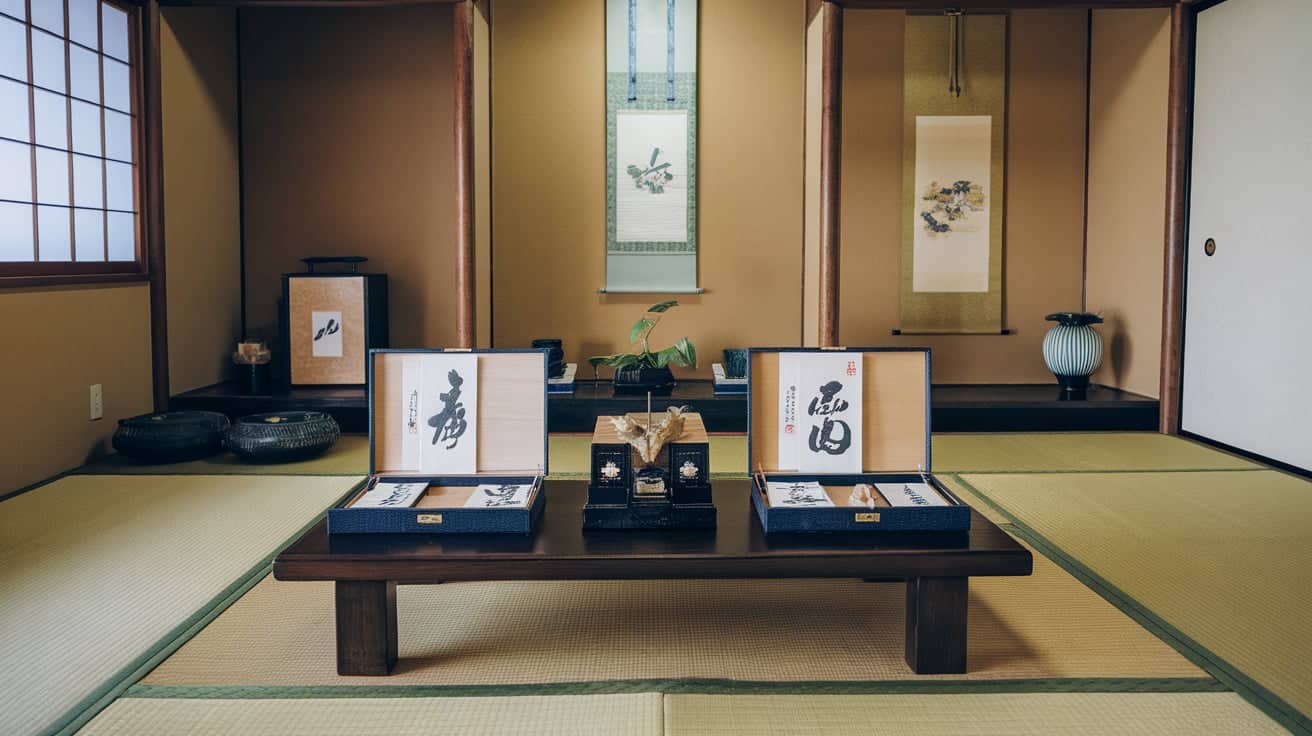
Calligraphy sets include brushes, ink, and paper designed for Japanese calligraphy, an art form emphasizing form and expression through kanji characters.
Calligraphy is a highly regarded art in Japanese culture. With roots in ancient China, it offers both aesthetic pleasure and meditative practice.
- Modern Usage: Calligraphy can be practiced as a hobby or art form in homes, and it is often displayed as part of the interior decor.
- Styling Tips: Framed calligraphy works can be displayed as part of a gallery wall or as a standalone piece to draw attention and add elegance.
- Benefits and Challenges: Calligraphy can be therapeutic and enriching; however, mastering this art form requires practice and patience.
23. Sudare
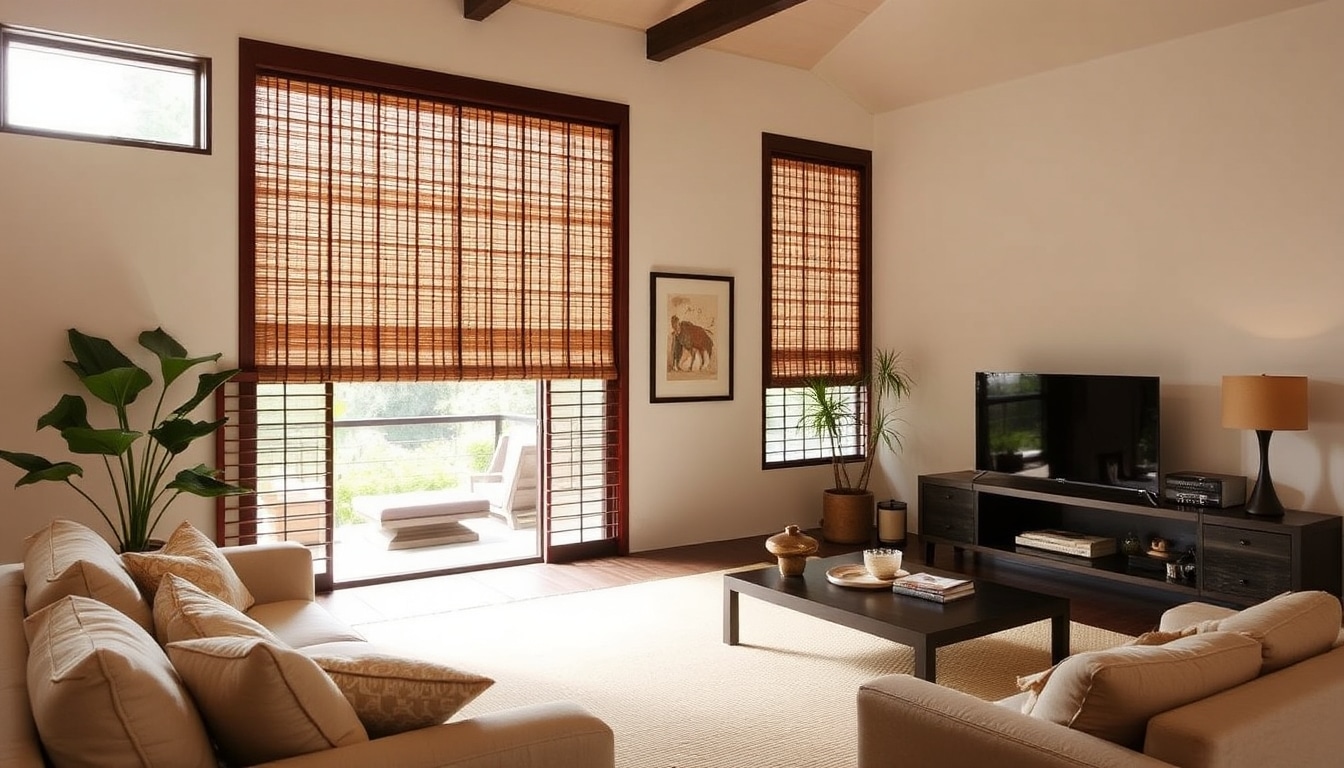
Sudare are bamboo blinds that serve both functional and aesthetic purposes, offering privacy and a diffused light effect.
They are traditionally used in Japanese homes to shield interiors from sun and rain while allowing air circulation.
- Modern Usage: Sudare fit well in modern decor as eco-friendly and visually appealing window treatments.
- Styling Tips: Integrate sudare in rooms that receive a lot of sunlight to soften the light and add a natural textural element.
- Benefits and Challenges: Sudare is environmentally friendly and adds an organic touch to interiors. However, it may not offer complete privacy or darkness and is suitable only for specific areas.
24. Sumi-e Paintings
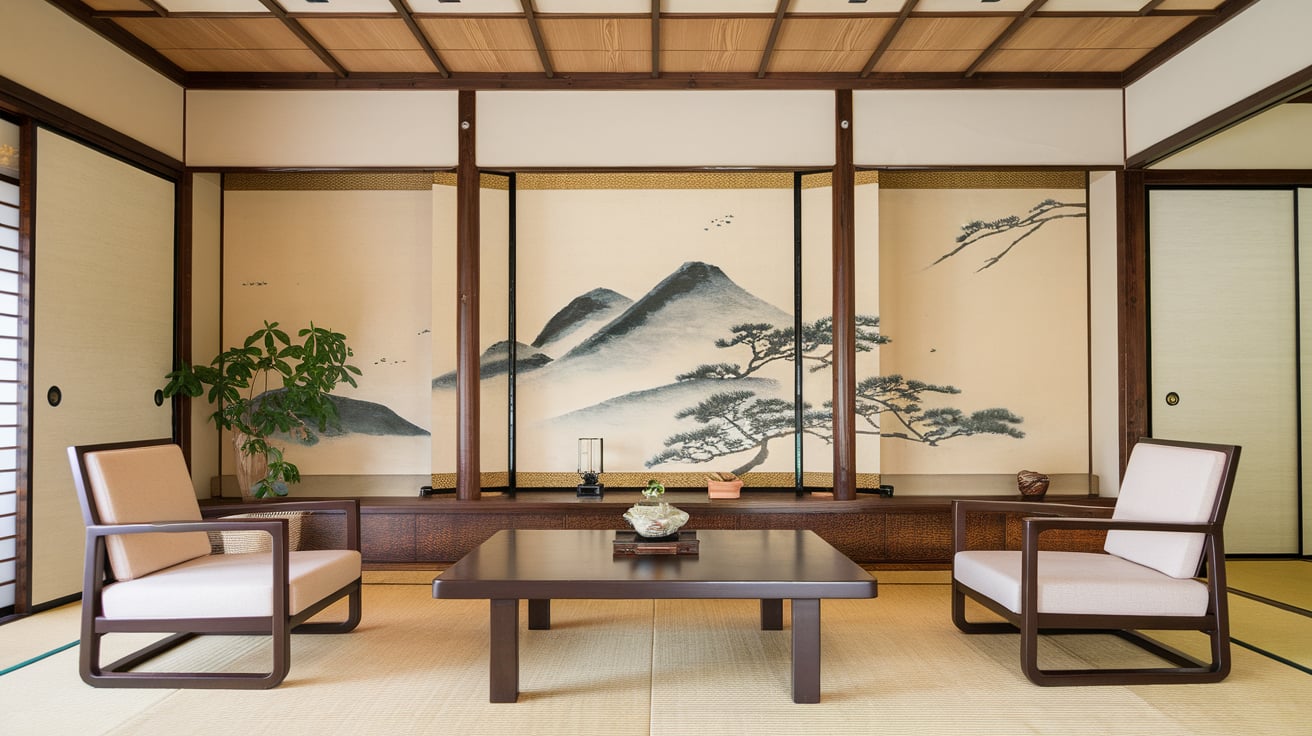
Sumi-e, or ink wash painting, focuses on simplicity and depth. It uses varying tones of black ink to create landscapes and other natural scenes.
Sumi-e originated in China and was perfected in Japan. It is a Zen-influenced art form that emphasizes the spiritual representation of nature.
- Modern Usage: These paintings are valued in contemporary settings for their minimalist aesthetic and contemplative nature.
- Styling Tips: Hang sumi-e paintings in quiet and minimal clutter areas to enhance their calming effect and artistic value.
- Benefits and Challenges: Sumi-e paintings can make a space appear more refined and tranquil but require a suitable backdrop and lighting to be fully appreciated.
25. Japanese Carpets
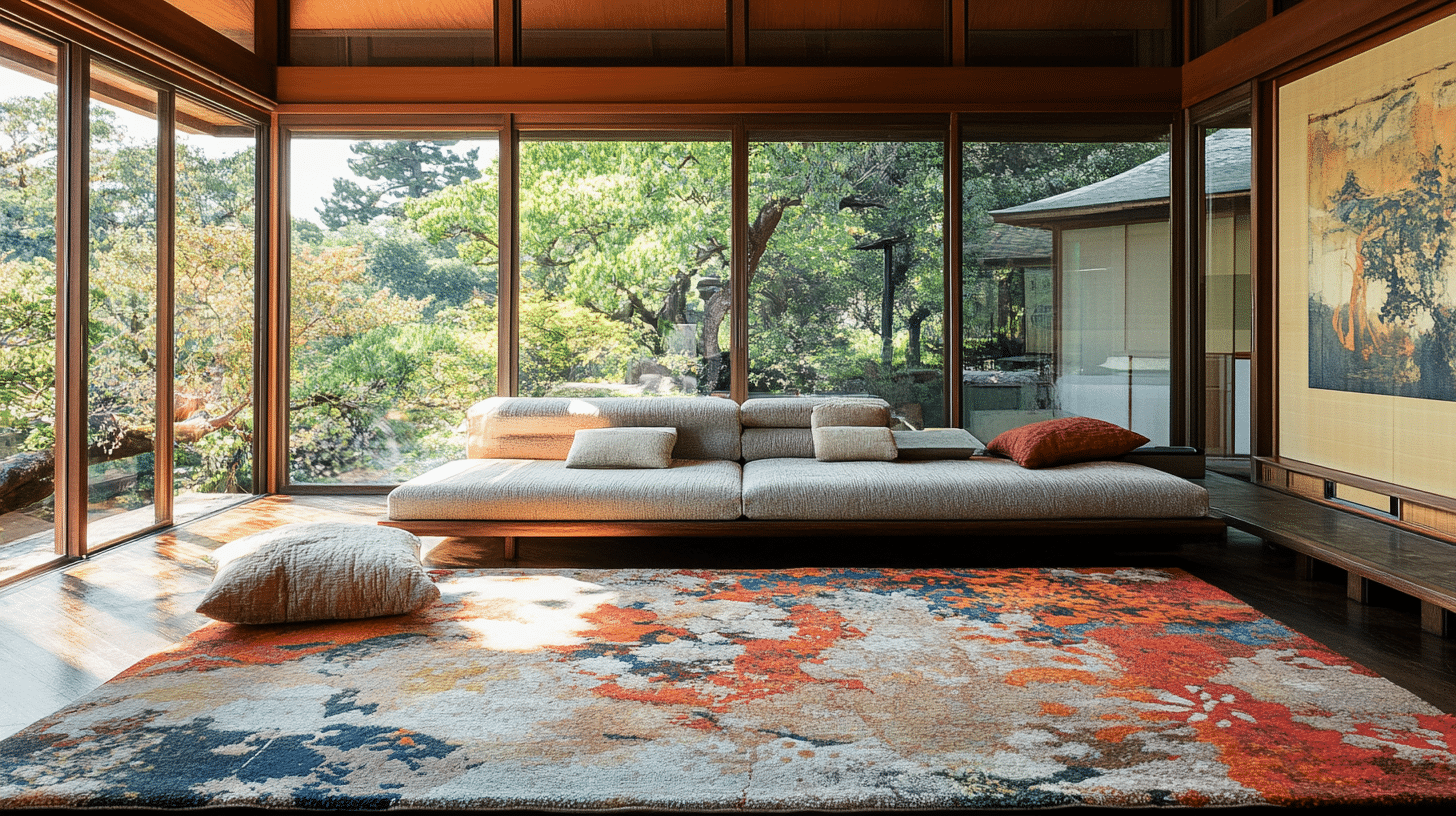
Japanese carpets, often featuring natural motifs and minimalistic designs, bring warmth and artistic expression to home floors.
Japanese textiles have a long history, with carpets often used in traditional settings to add comfort and decoration.
- Modern Usage: Modern Japanese carpets can anchor a room’s decor, adding softness and style without overwhelming the space.
- Styling Tips: Use carpets with subdued colors and organic patterns to complement a minimalist decor scheme.
- Benefits and Challenges: Carpets enhance a room’s comfort and aesthetic but require regular maintenance to keep them clean and in good condition.
26. Silk Pillows
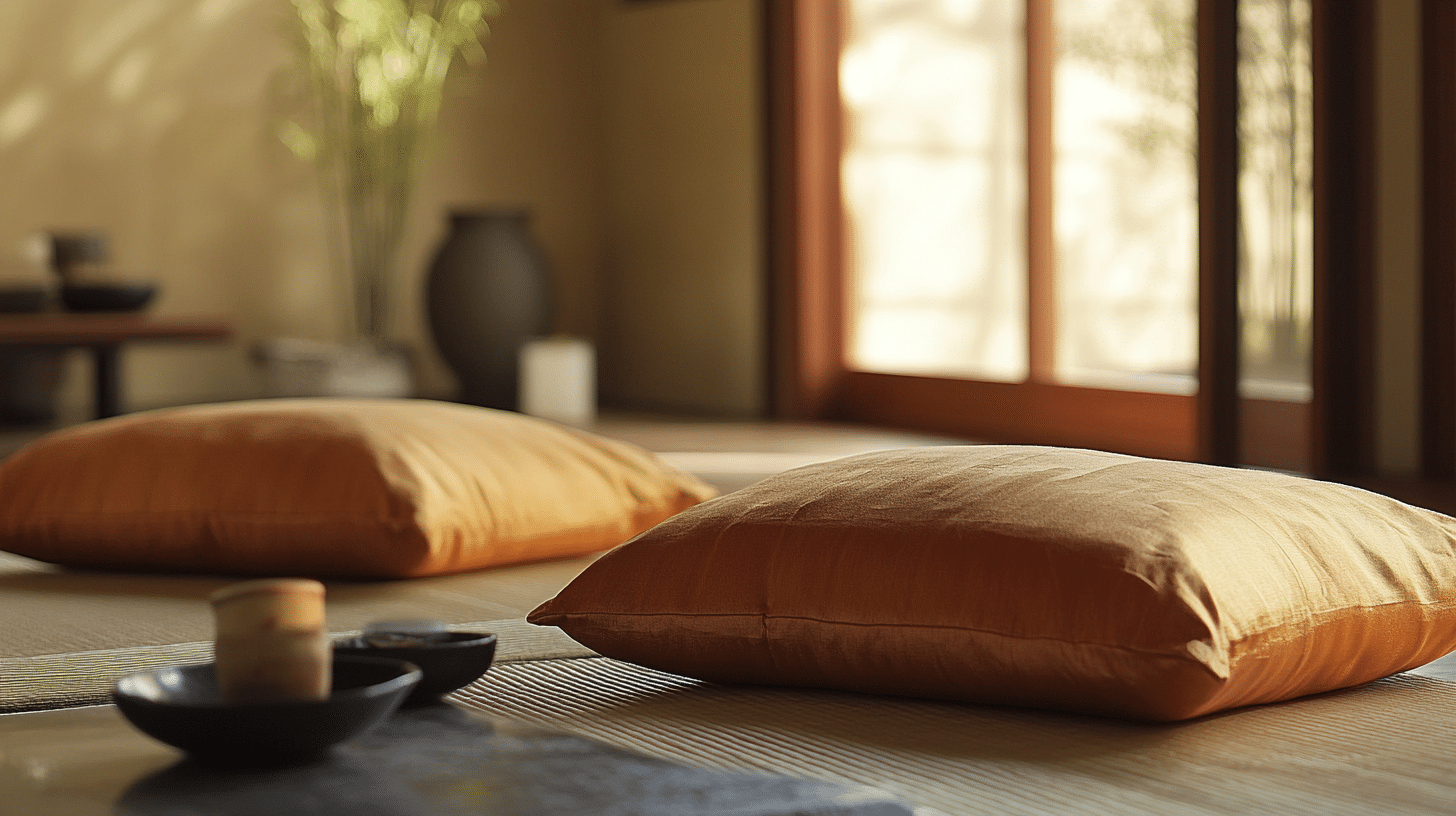
Silk pillows are luxurious accessories that can add a touch of elegance and comfort to any living space. They often feature traditional Japanese designs.
Silk is a valued material in Japan for its beauty and texture. It is traditionally used in kimonos and decorative arts.
- Modern Usage: Silk pillows enhance the decor of modern homes, bringing color and softness to seating and sleeping areas.
- Styling Tips: To maintain a balanced look, choose silk pillows with subtle patterns or colors that complement the room’s overall color scheme.
- Benefits and Challenges: Silk pillows provide an upscale aesthetic and are gentle on the skin. However, they require careful maintenance to preserve their color and texture.
27. Stone Lanterns
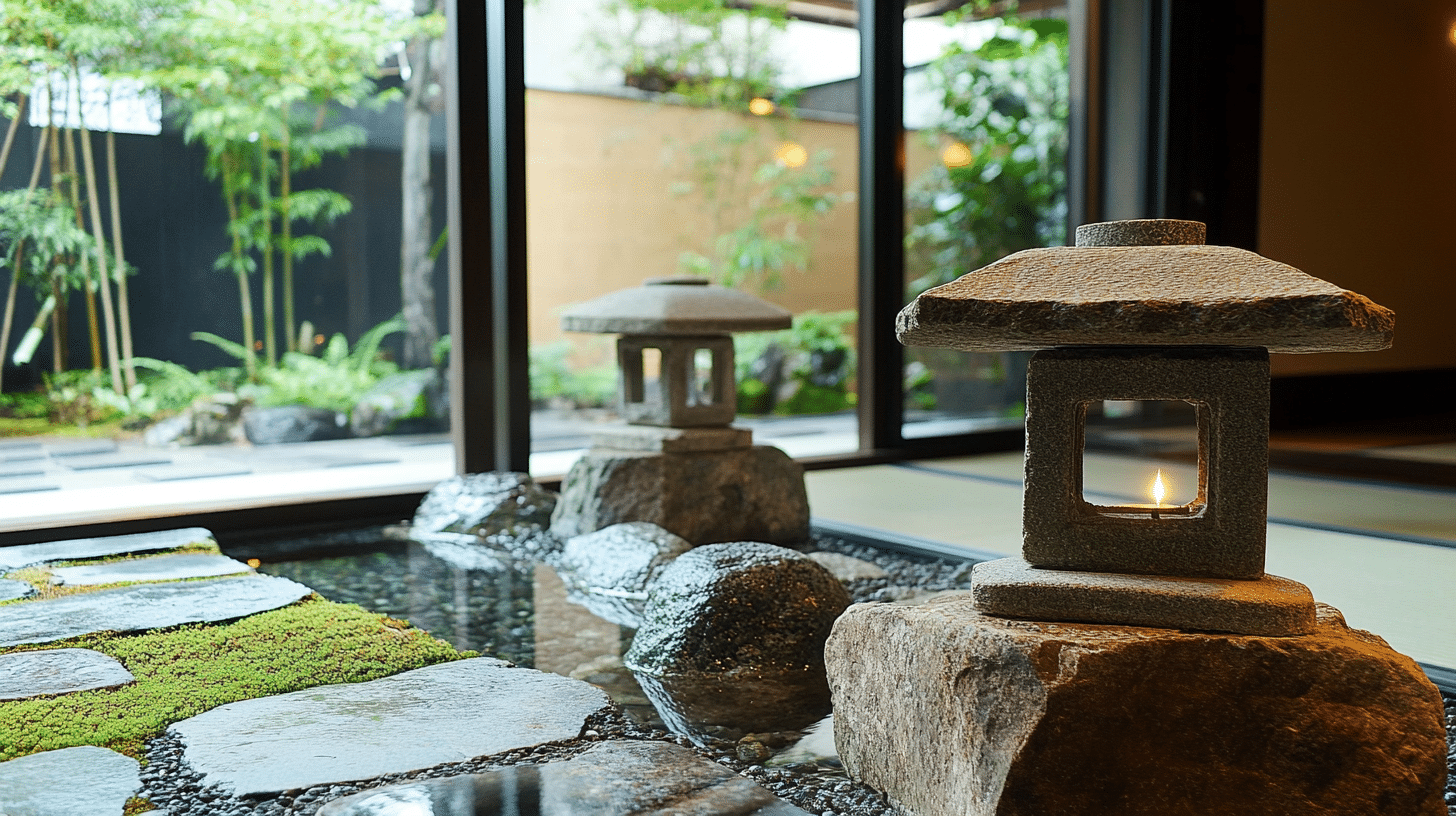
Stone lanterns, originally used in Buddhist temples and tea gardens, provide a historic and serene addition to any living space, indoors or in garden settings.
These lanterns date back to medieval Japan, where they were used to line and illuminate paths in sacred and communal spaces.
- Modern Usage: Indoors, stone lanterns can serve as a focal decorative element, often used with candles or small lights.
- Styling Tips: Position a stone lantern in a visible corner of the room or near entryways to create a welcoming and tranquil atmosphere.
- Benefits and Challenges: Stone lanterns add a timeless aesthetic and cultural depth but are heavy and require a sturdy base to ensure safety and stability.
28. Woodblock Prints
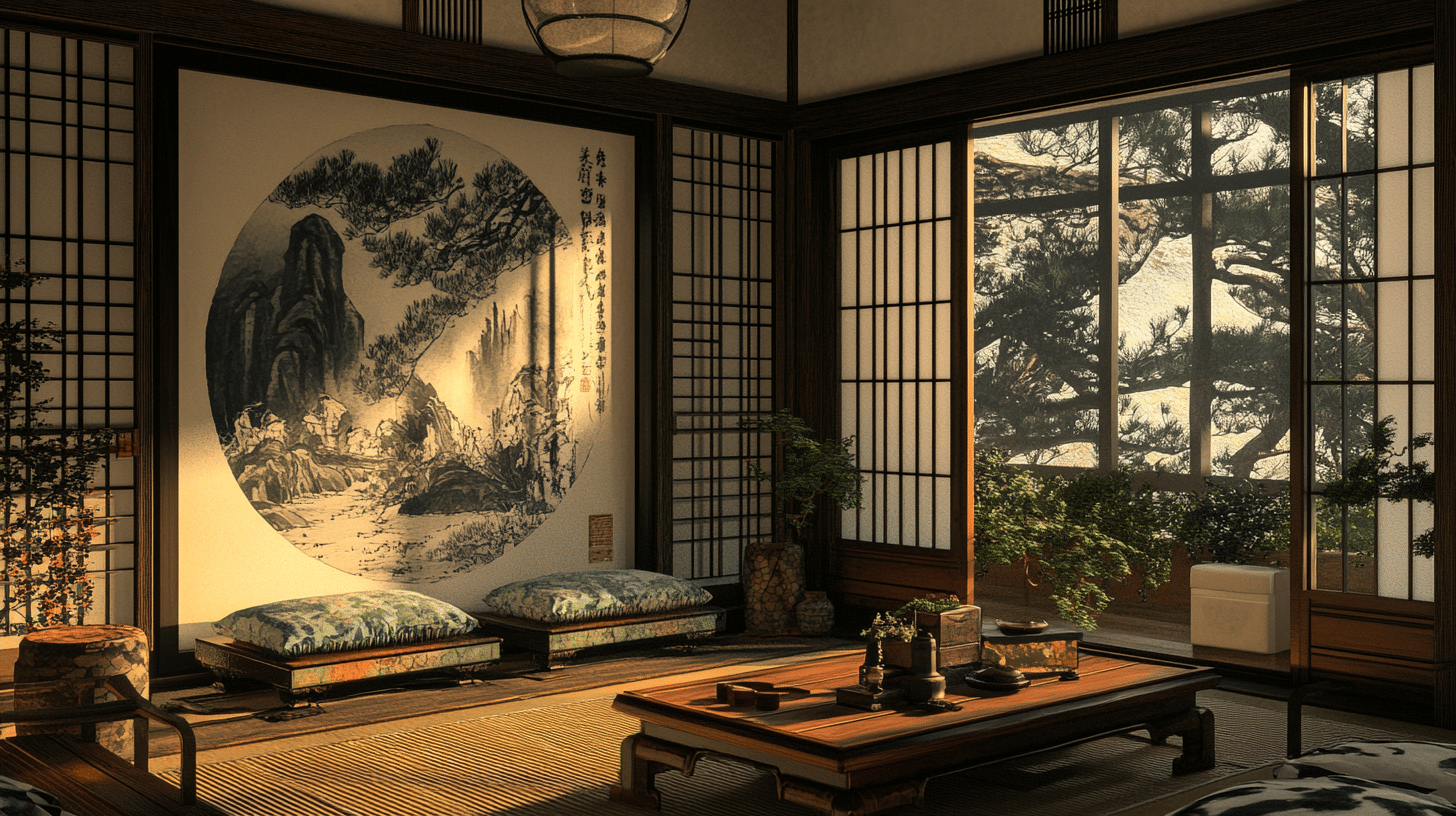
Woodblock prints, known as ukiyo-e, depict scenes of historical narratives, flora, and leisure activities. They are iconic in Japanese art and can dramatically enhance any room’s decor.
Popularized during the Edo period, these prints were mass-produced as affordable art for the burgeoning middle class. They captured everyday life and landscapes.
- Modern Usage: These prints are frequently used as wall art in homes and appreciated for their vivid colors and stylized imagery.
- Styling Tips: Frame woodblock prints with simple, elegant frames to focus attention on the intricate details and colors of the artwork.
- Benefits and Challenges: Woodblock prints are a great way to add vibrant historical art to modern decor. However, they can fade if exposed to direct sunlight, so placement is crucial.
29. Oshiire
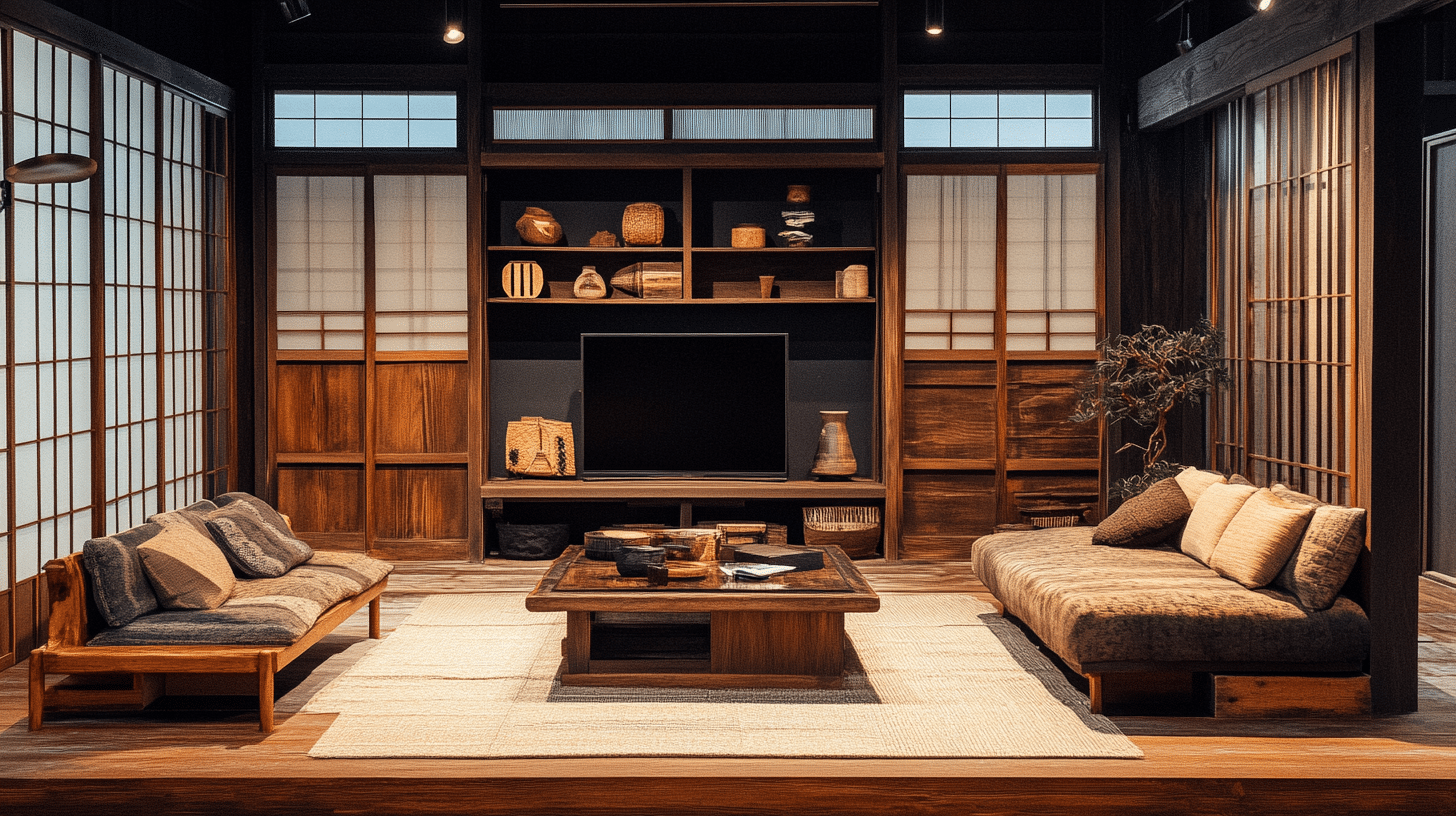
Oshiire are traditional Japanese closets used for storing futons and bedding during the day. They promote a minimalist and tidy living space.
Integral to the Japanese custom of stowing away bedding, oshiire helps maintain the multifunctionality of rooms.
- Modern Usage: In contemporary homes, oshiire can be adapted to store various items, keeping living spaces uncluttered and versatile.
- Styling Tips: Utilize oshiire in bedrooms or living areas where easy access to stored items is beneficial without compromising aesthetics.
- Benefits and Challenges: Oshiire maximizes floor space and keeps rooms organized but may require custom construction to fit specific living spaces.
30. Fusuma
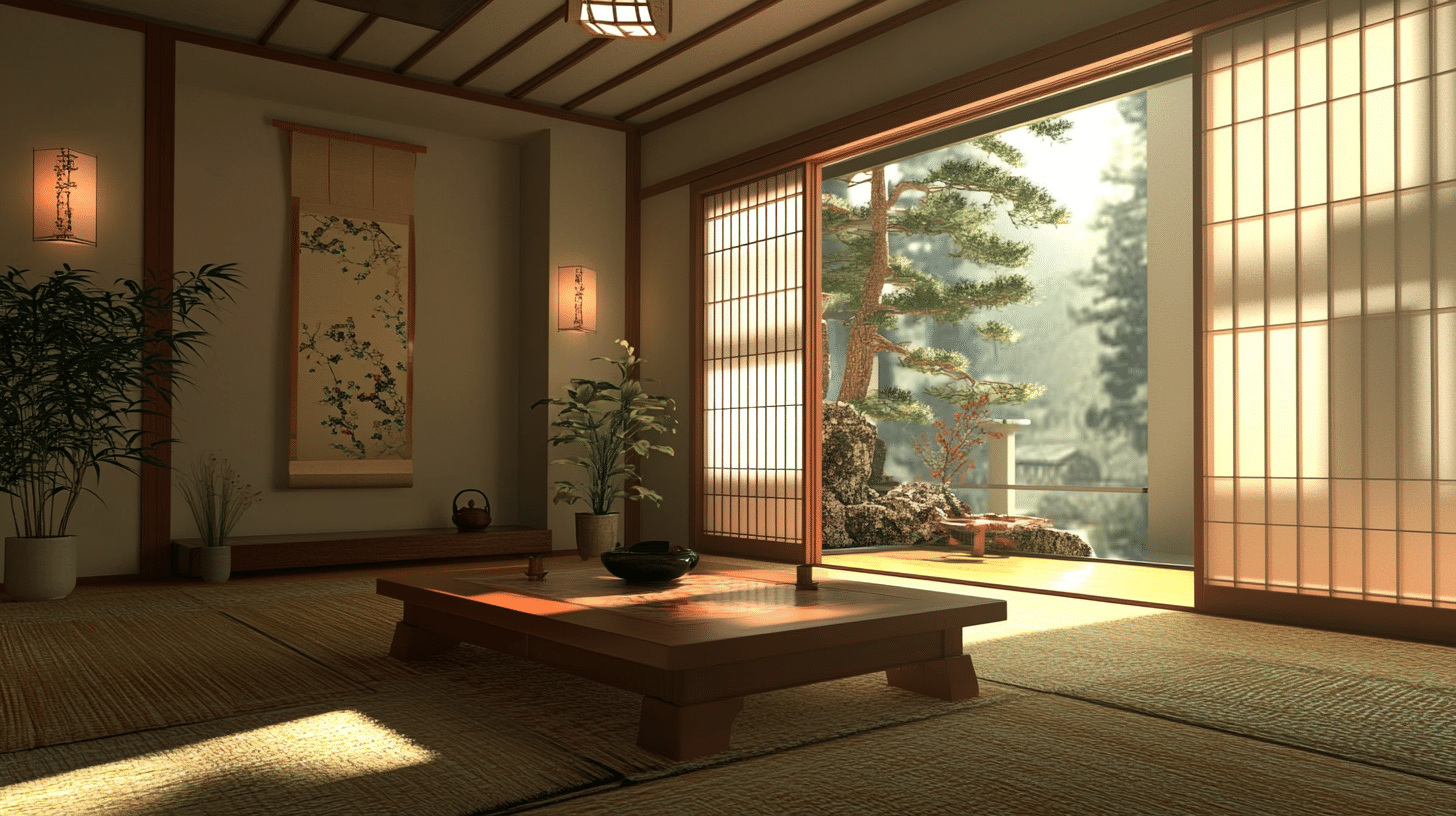
Fusuma are sliding panels covered in thick, opaque paper or fabric. They are used to separate rooms or conceal storage, blending functionality with traditional aesthetics.
Used in traditional Japanese architecture, fusuma allows for flexible room configurations and privacy.
- Modern Usage: Fusuma are incorporated into modern homes to divide larger spaces or as closet doors, maintaining a clean and minimal look.
- Styling Tips: To enhance visual harmony, customize fusuma panels with subtle patterns or textiles that complement other room elements.
- Benefits and Challenges: Fusuma are excellent for space flexibility and modern adaptability but can wear over time and require maintenance or replacement of the paper or fabric.
31. Japanese Clocks
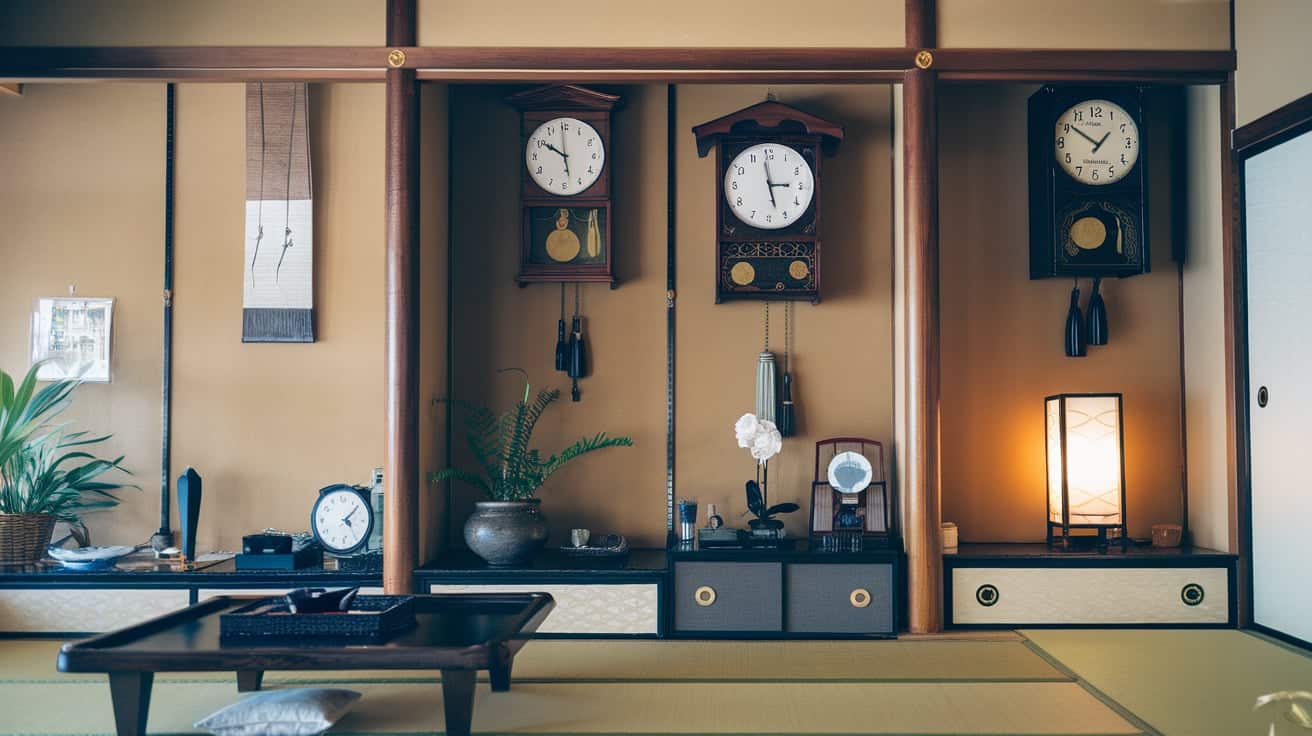
Japanese clocks often blend traditional and modern design elements, subtly enhancing a room’s aesthetic while providing practical timekeeping.
Japan’s unique time-keeping approach has evolved from sun-based clocks to modern mechanical and digital clocks, reflecting a mix of Western influences and Japanese craftsmanship.
- Modern Usage: Japanese clocks are used in homes not just for function but also as decorative pieces, often with minimalistic and elegant designs.
- Styling Tips: Choose a clock with a simple, clean design that complements a Japanese living room’s serene and uncluttered aesthetic.
- Benefits and Challenges: These clocks can be a focal point in room decor, but selecting a style that balances modern functionality with traditional aesthetics can be challenging.
32. Paper Fans
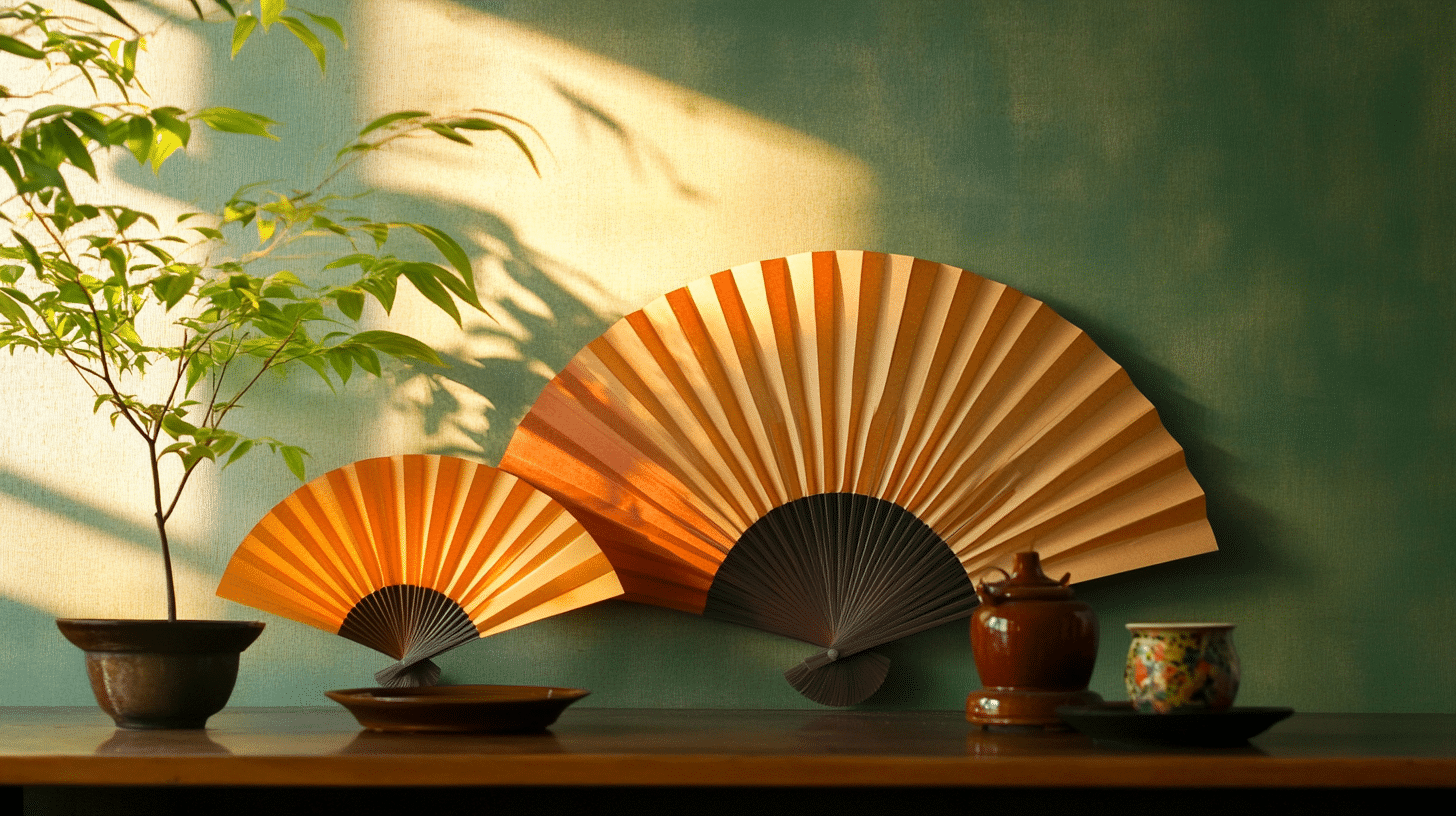
Paper fans, both functional and decorative, are a traditional Japanese item adorned with various designs, ranging from simple color blocks to intricate paintings.
Used historically in both daily life and in ceremonial contexts, paper fans have become symbols of Japanese cultural art and craftsmanship.
- Modern Usage: Paper fans add a cultural touch to contemporary home decor, whether displayed as wall art or used as practical cooling tools.
- Styling Tips: To enhance their visual impact, arrange paper fans in a display case or hang them on walls as part of a larger art collection.
- Benefits and Challenges: Paper fans are lightweight and versatile decorations but are delicate and require careful handling to maintain their condition.
33. Wooden Bowls and Utensils
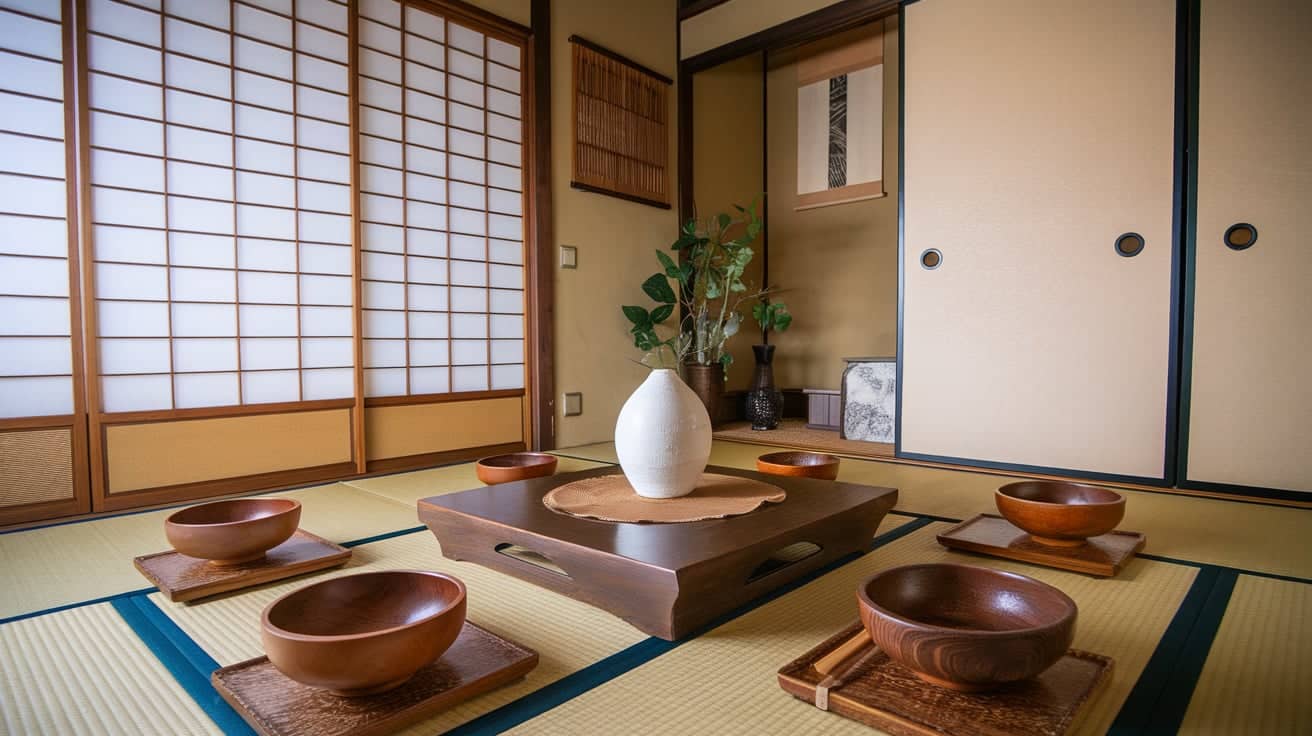
Wooden bowls and utensils, crafted from various types of wood, are essential in Japanese dining and also serve as rustic decorative elements in the kitchen or dining area.
Traditionally valued for their natural aesthetic and durability, wooden kitchen items have been used in Japan for centuries.
- Modern Usage: These items are used for both everyday meals and special occasions and are celebrated for their beauty and functionality.
- Styling Tips: Display wooden bowls and utensils on open shelves or hanging racks to add warmth and an organic touch to kitchen decor.
- Benefits and Challenges: Wood provides a natural, warm aesthetic to any space but requires regular maintenance to prevent damage and preserve its appearance.
34. Raku Pottery
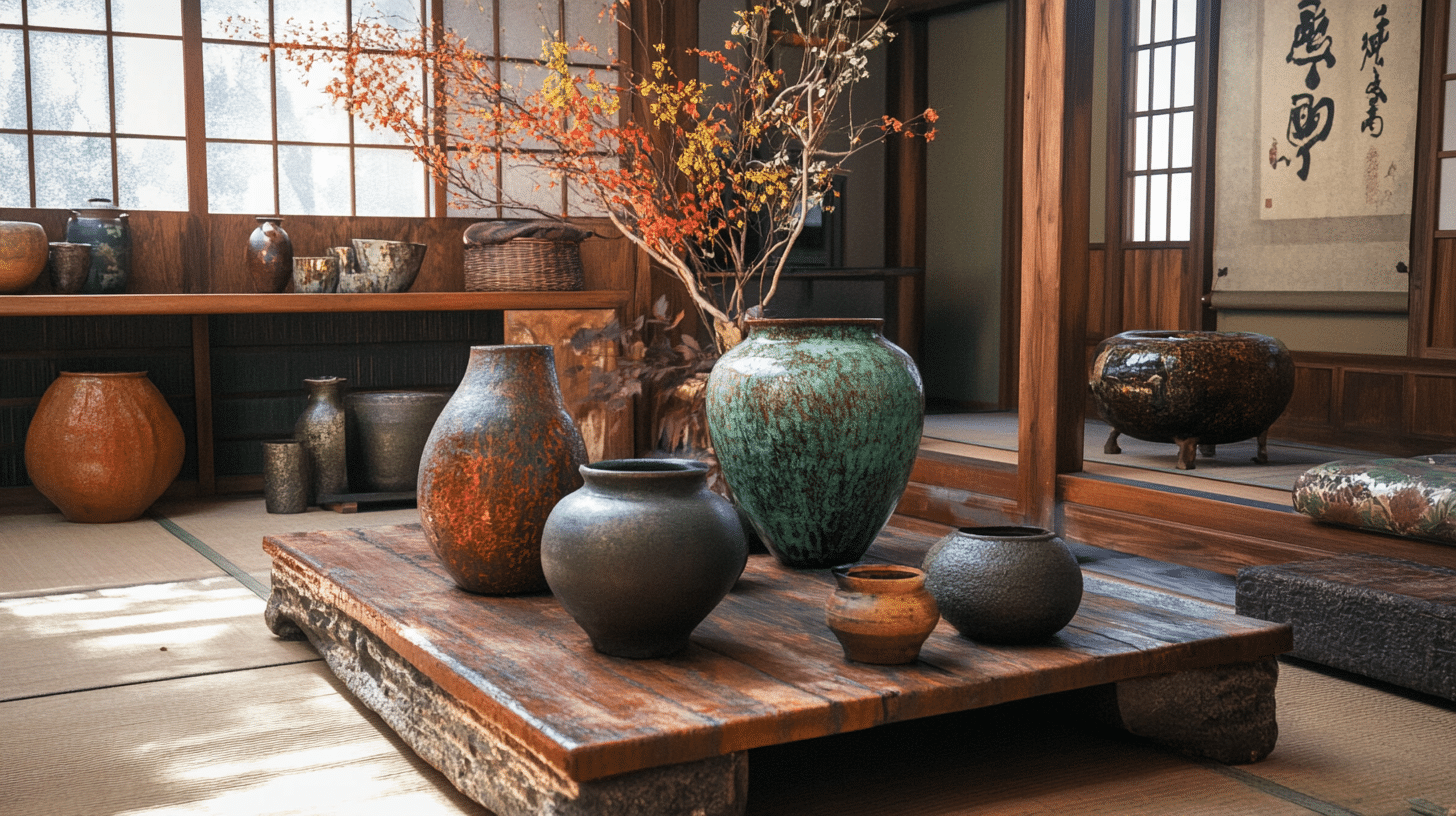
Raku pottery, known for its distinctive crackled glaze and irregular shapes, represents a celebrated form of Japanese ceramic art, ideal for decorative purposes.
Developed in the 16th century as part of the tea ceremony, Raku pottery is appreciated for its wabi-sabi (beauty in imperfection) aesthetic.
- Modern Usage: Used as décor in modern homes, Raku pottery pieces are often displayed as standalone art pieces or used for serving special dishes.
- Styling Tips: Place Raku pieces on display shelves or in glass cabinets where their unique textures and colors can be appreciated from different angles.
- Benefits and Challenges: Raku pottery adds an artistic touch and cultural depth to décor but is fragile and requires careful handling and placement.
35. Silk Wall Hangings
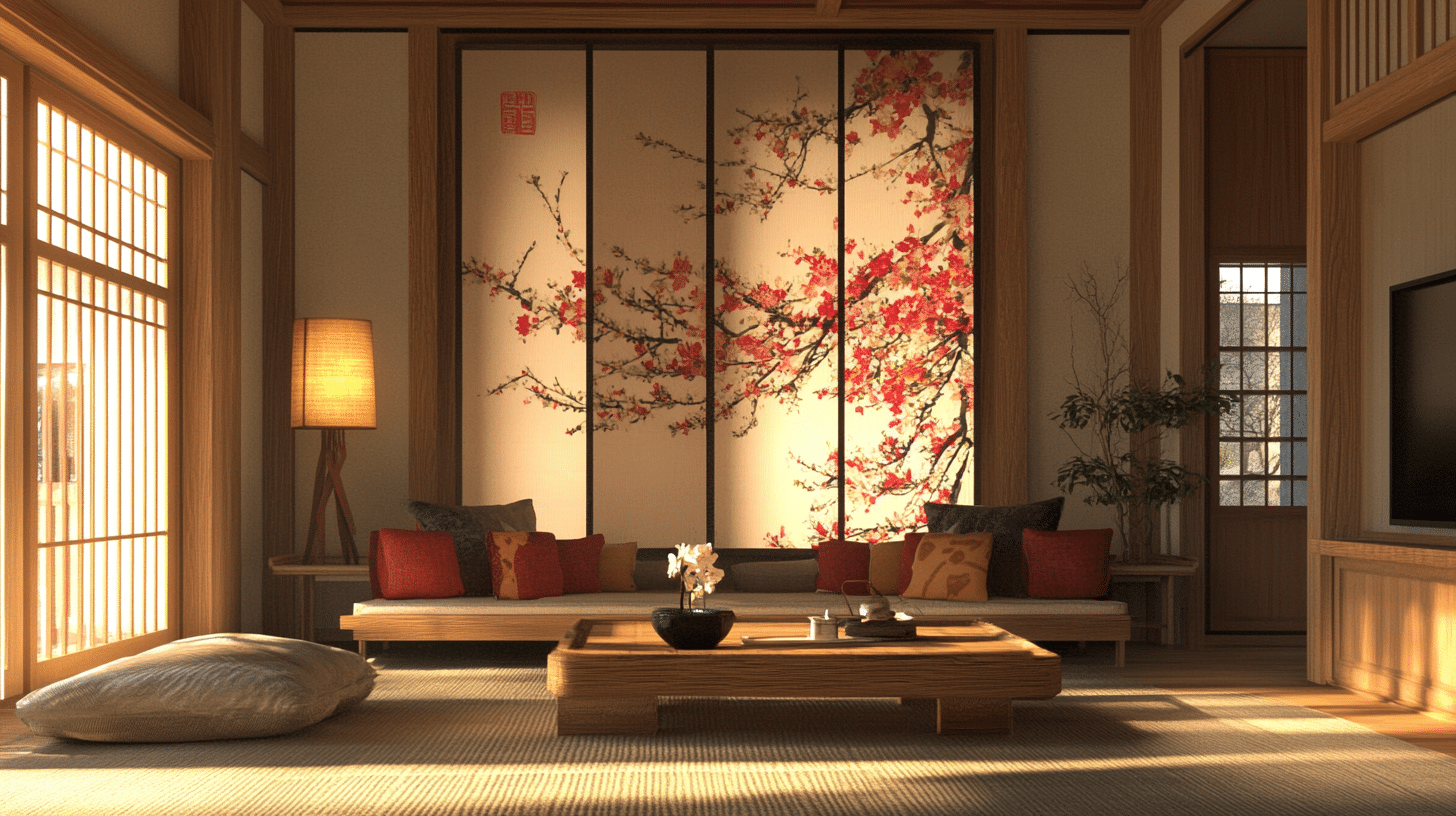
Silk wall hangings adorned with traditional Japanese motifs or scenes provide a sophisticated and culturally rich element to any room’s decor.
Silk textiles have been a luxurious export item for Japan, historically used in garments and decorative arts.
- Modern Usage: Silk hangings bring elegance and color to contemporary spaces as wall decor, often featuring scenes from nature or classical literature.
- Styling Tips: Hang silk wall pieces in well-lit areas where their detail and texture can be fully appreciated without direct sunlight that may cause fading.
- Benefits and Challenges: Silk wall hangings can dramatically enhance a room’s aesthetic but require careful maintenance to preserve their vibrant colors and delicate fabrics.
Conclusion
Creating a Japanese living room is more than just picking out furniture. It’s about crafting a space that brings peace and balance to your home.
We’ve explored 35 items to help you achieve this look, from simple tatami mats to sleek shoji screens. Each piece adds its touch of Japanese charm.
Remember, the key is to keep things uncluttered and purposeful. Start small – maybe add a low table or a paper lantern.
As you add more elements, your room will transform into a serene Japanese retreat. Why not begin your Japanese living room travel today?
Take a look around your space and think about which items might fit. Your path to a more peaceful home starts with that first step.

